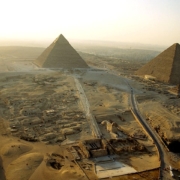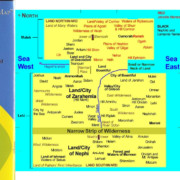For sticky posts
Book of Mormon Geography Found- Mexican Highland Continental Model (summary)
/in archaeology (sticky posts), Featured Posts/by MormonBoxby Lance Weaver
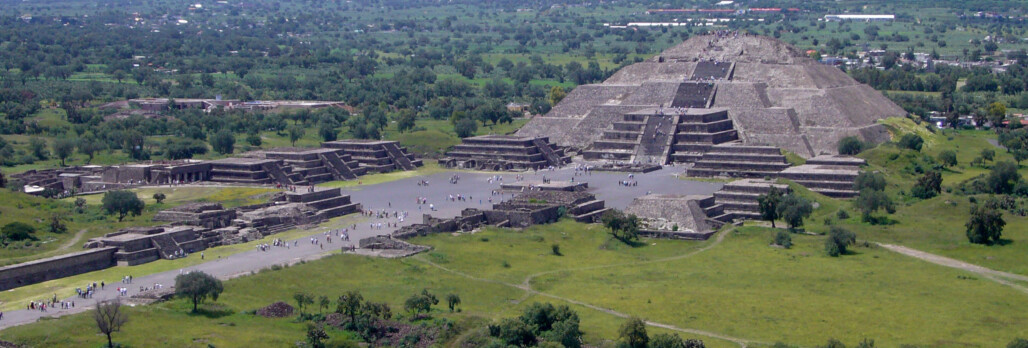
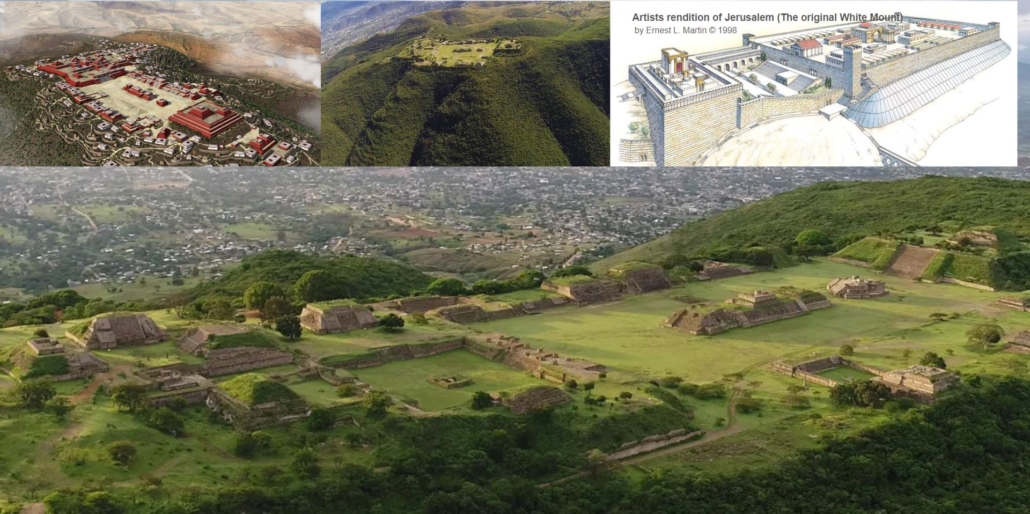
Outline
This article is only a very rough draft or summary of a much larger book I’m writing which I don’t expect to finish for at least a decade.
- Introduction
- Summery of what sets this model apart.
- Internal Model. (compare a bit to heartland and Mesoamerica)
- The Continental Model of Joseph Smith
- The writings of Ixtlilxochitl
- The Caractors document.
- The Narrow Neck.
- Arrival of the Jaredites (put after Nephites?)
- Omer and his household
- Post Dearth Jaredite culture
- Colonial arrivals (arrival writing, pyramids)
- Olmec or Zapotec as the mother culture? (Emergence of Zapotec hieroglyphic writing and calendrics to Mesoamerica)
- The move the Zarahemla
- The Seven Tribes of Early athors (find quotes) Matching BOM seven tribes.
- Zeniff and the City of Nephi
- Towers AND temple matching so well Noah’s building project.
- The emergence of the Zapotec Military State. (skull racks & warefare)
- Captain Moroni: Fortifying the Balsas Basin & Mexican Highland
- Mixtec sites move to fortresses & garrisons on East Coast.
- The people of Ammon in Jershon, linguistics matching matriarchal society of…
- Could the major Burial of Chiape de Corzo be Lamoni’s father?
- Lachoneous and the Founding of Teotihuacan
- Cataclysms at the coming of Christ
- Ixtextla records. Known volcanism and destruction of towns. PROBLEMS WITH RADIOCARBON DATING. (see txt file ‘anomalous old c14 dates in archaeology papers folder in drive)
- Tetimpa, Cuicuilco and Cholula were covered with volcanic ash like Pompaii right near the time of Christ. Zarahemla of Sorenson or Usamacinta models are 100 miles or more from the single active volcanic center. [make map of mexico’s active volcanoes]
- The tents, houses of cement (adobe) and shipping of timber in the desolate southwest.
- The golden or ‘Classic’ age of Zion
- Was Mormon Anasazi? A case for time discrepancies in 4rth Nephi
- The land of Desolation (matching accounts of Aztlan so well)
- The destruction of American Civilization
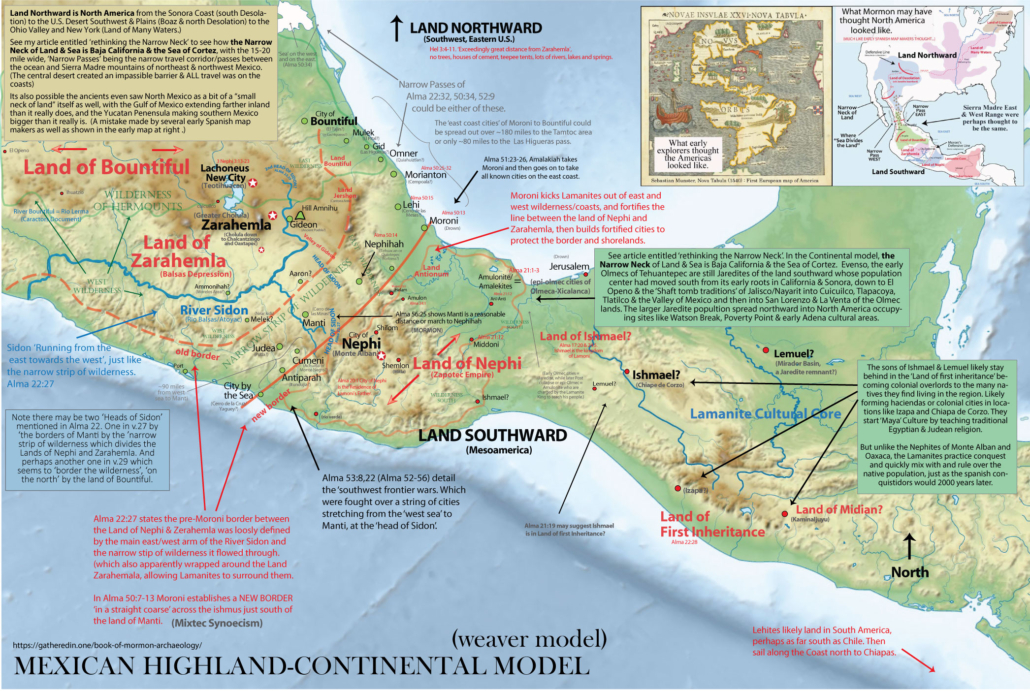
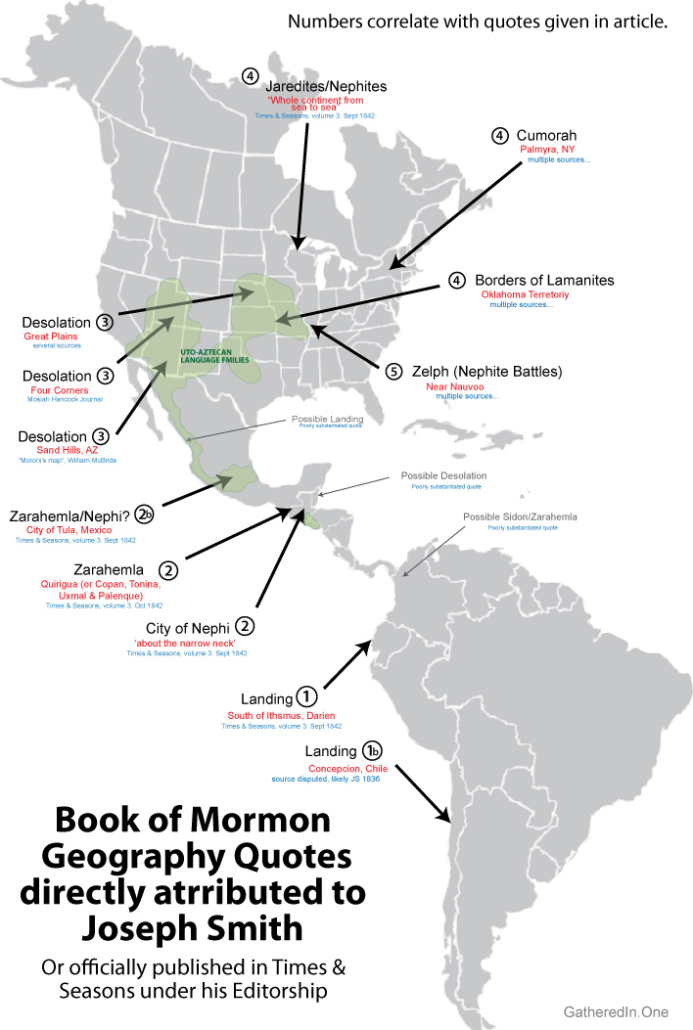
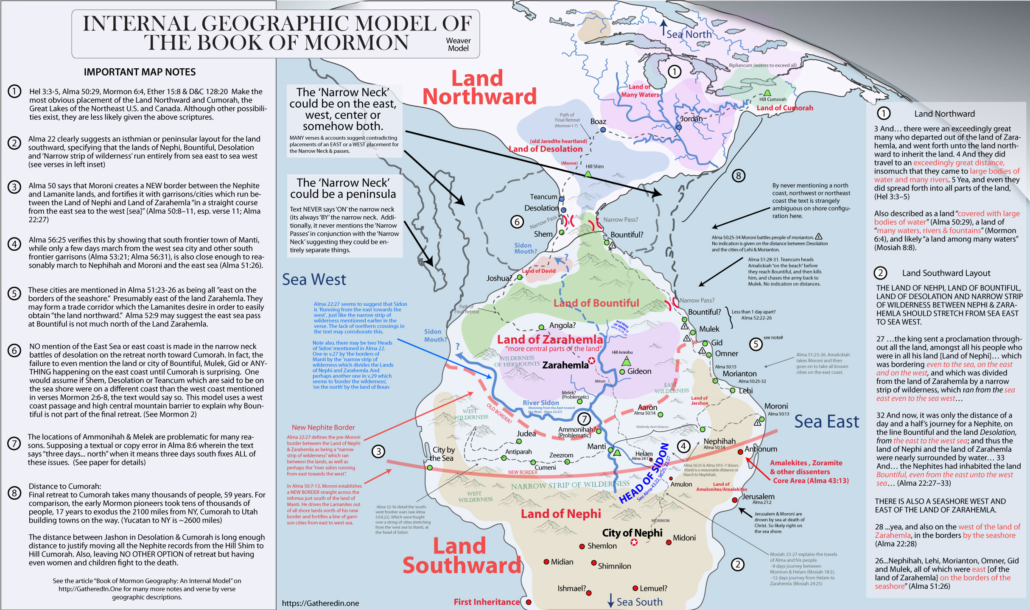
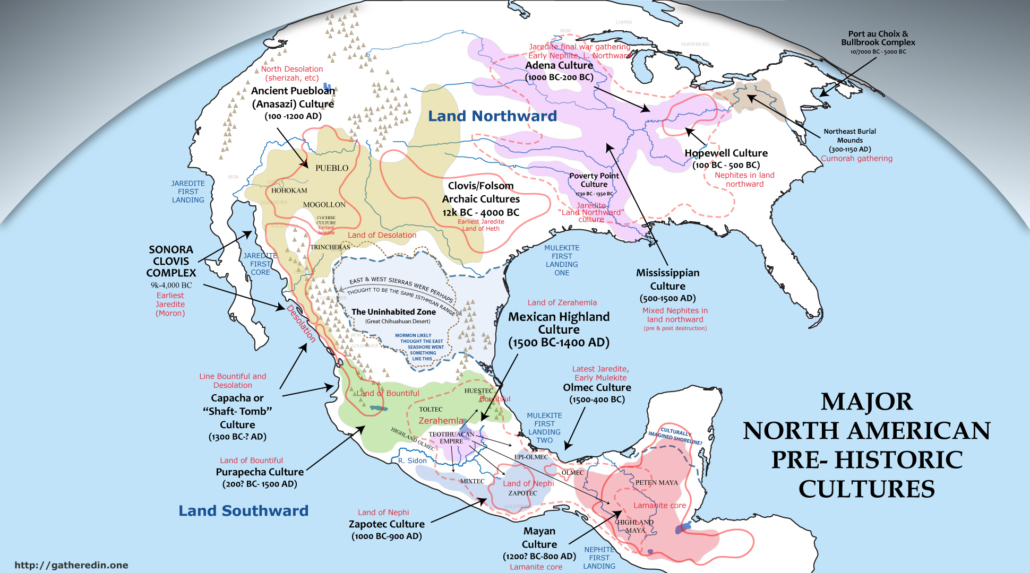

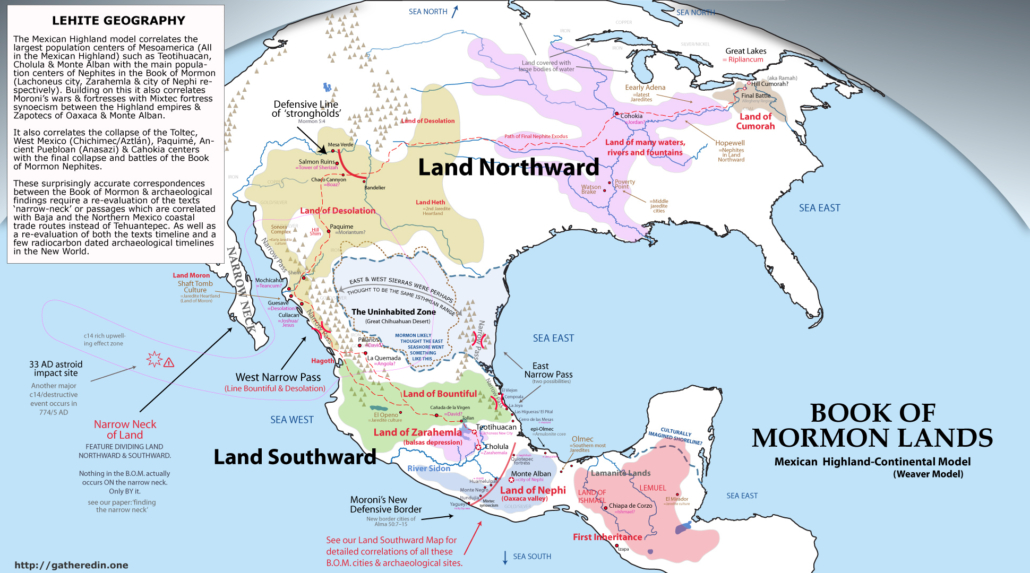
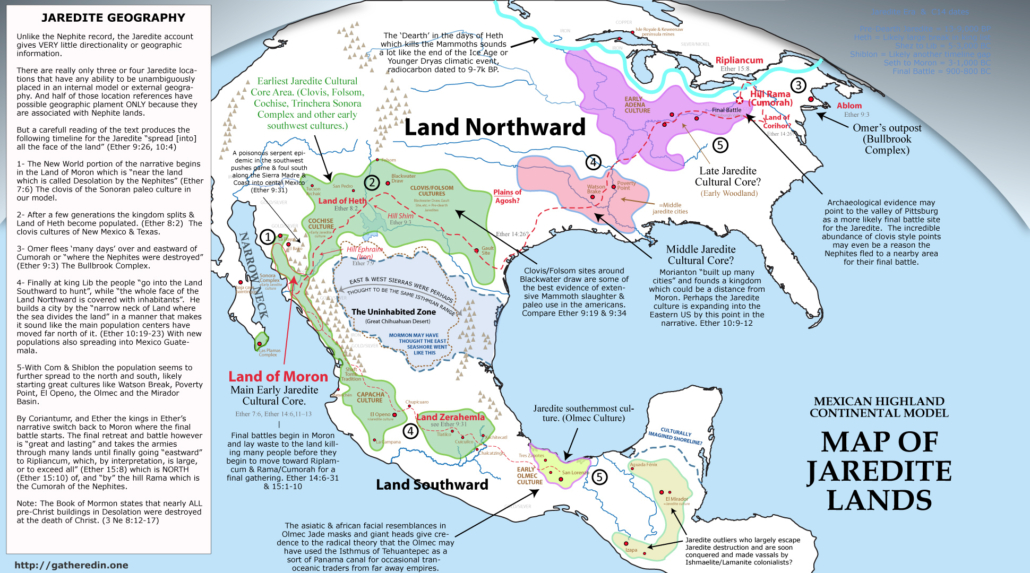
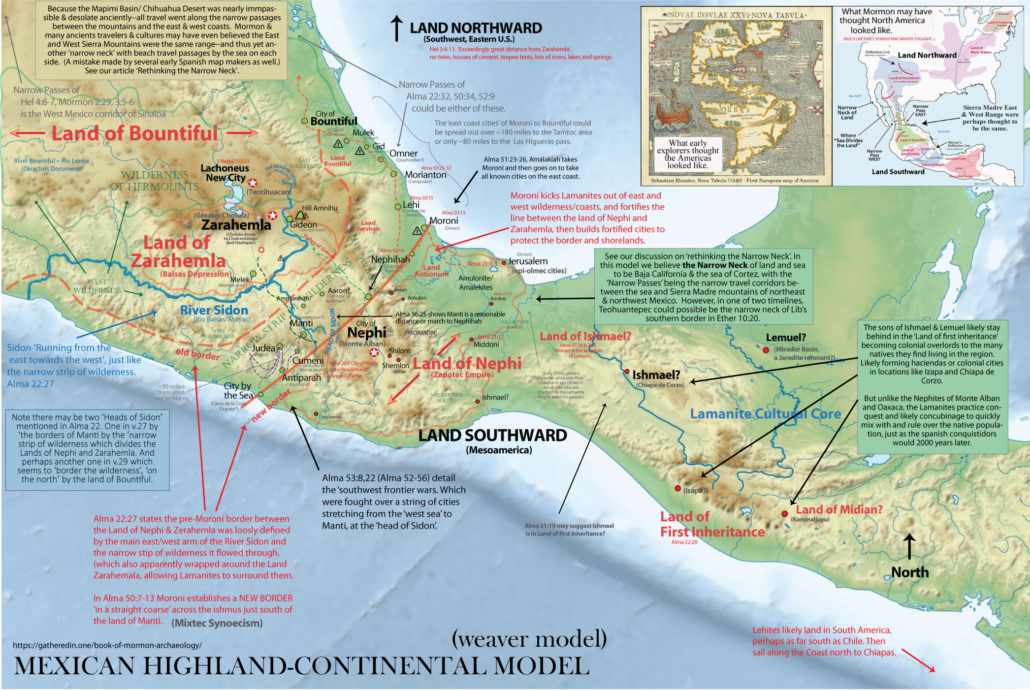
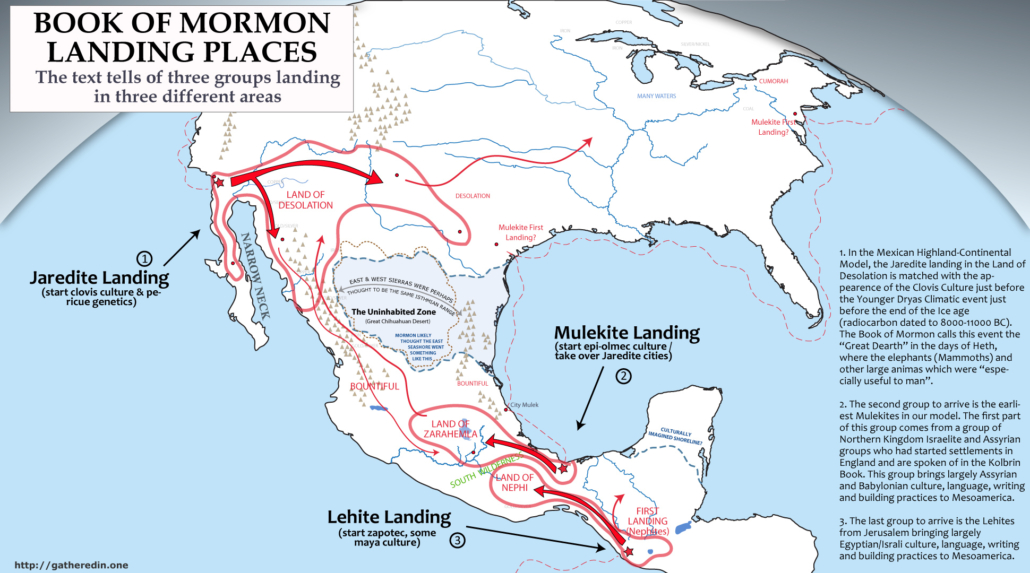
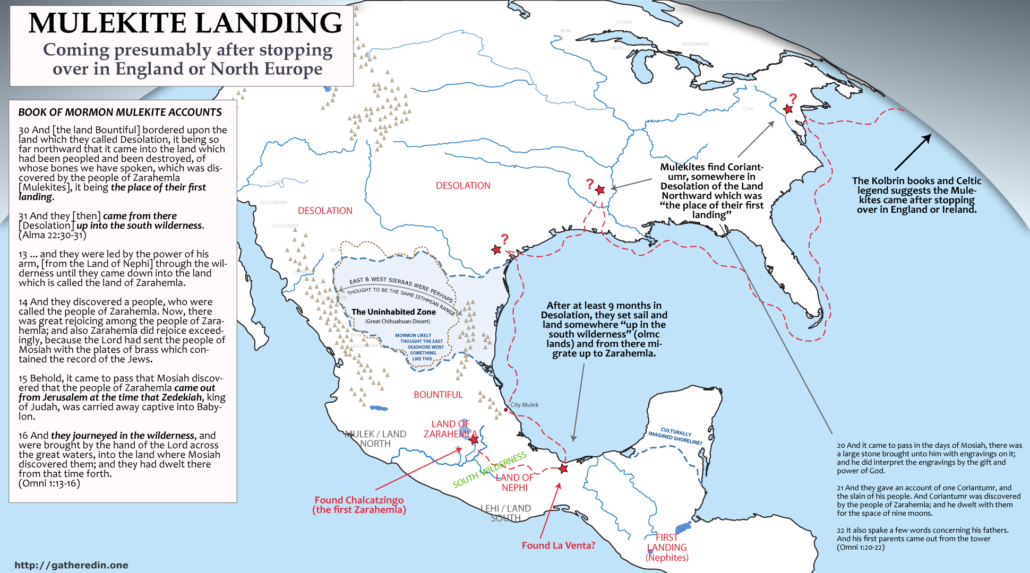
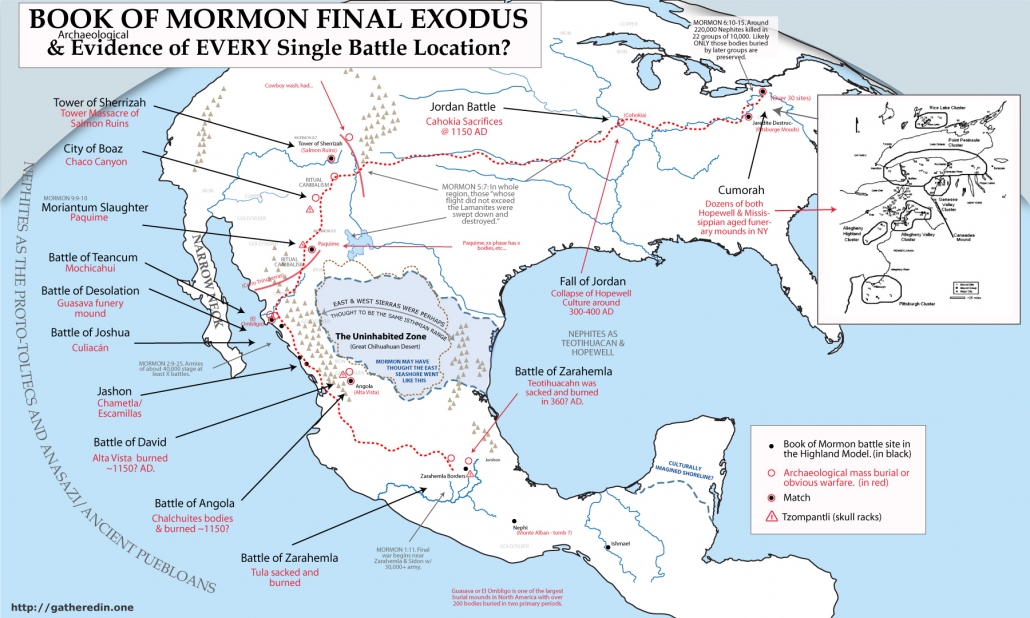
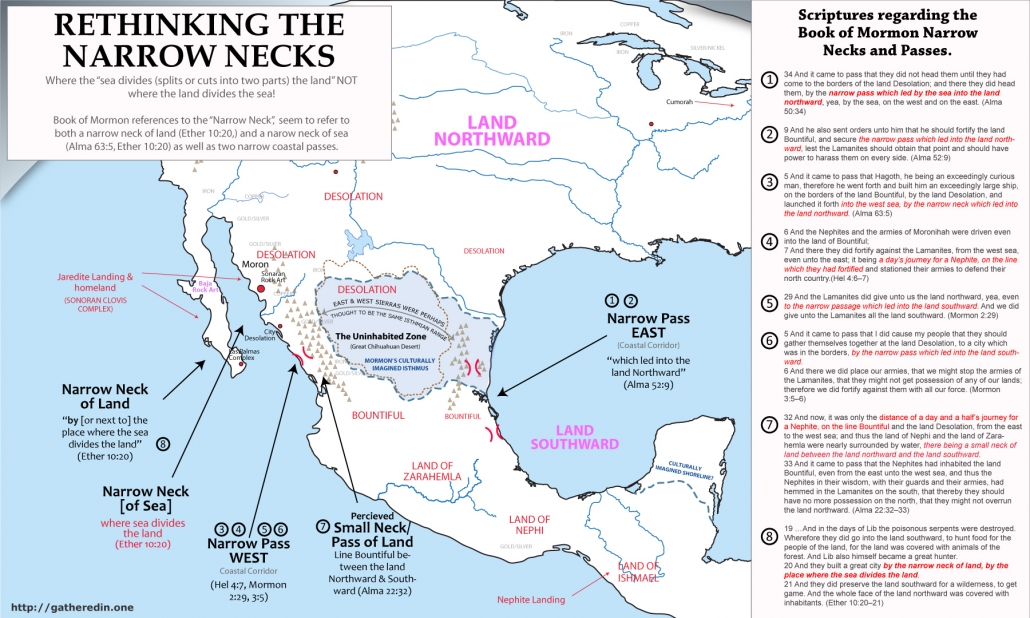

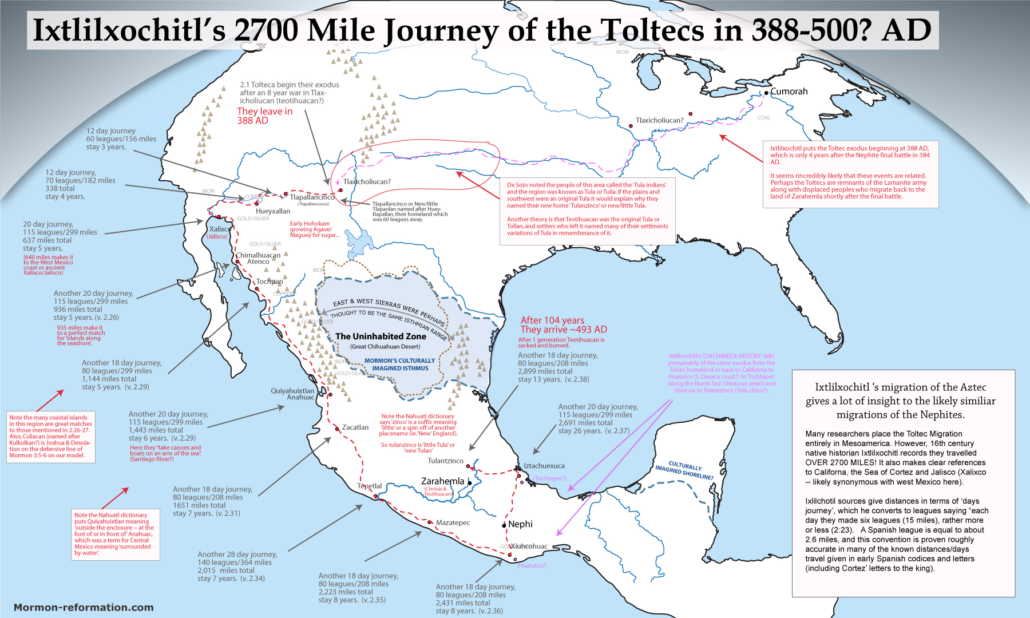

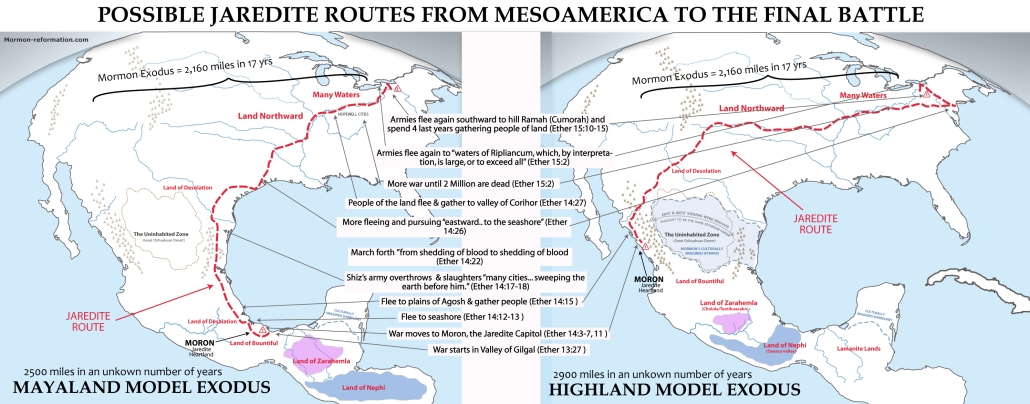
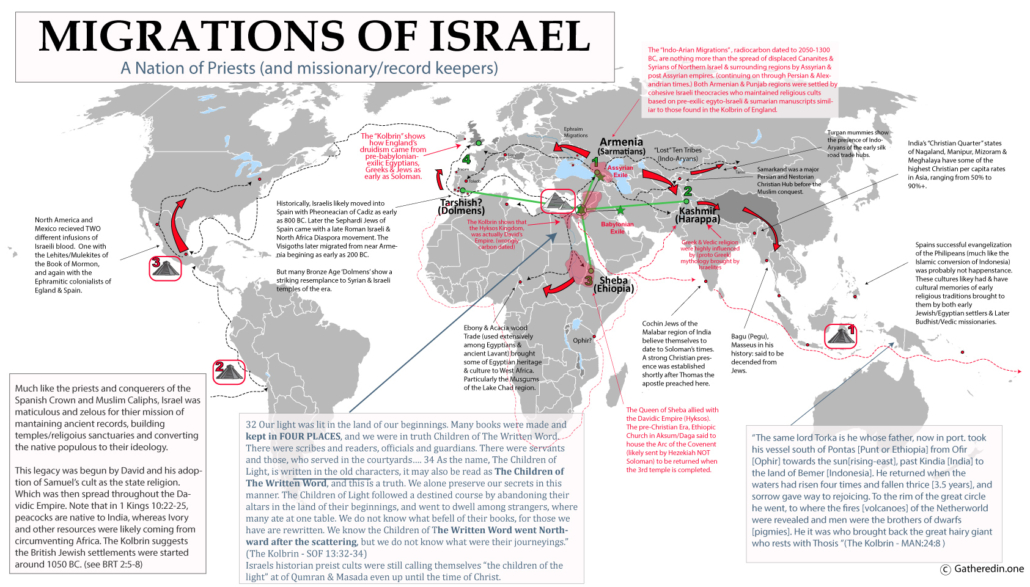

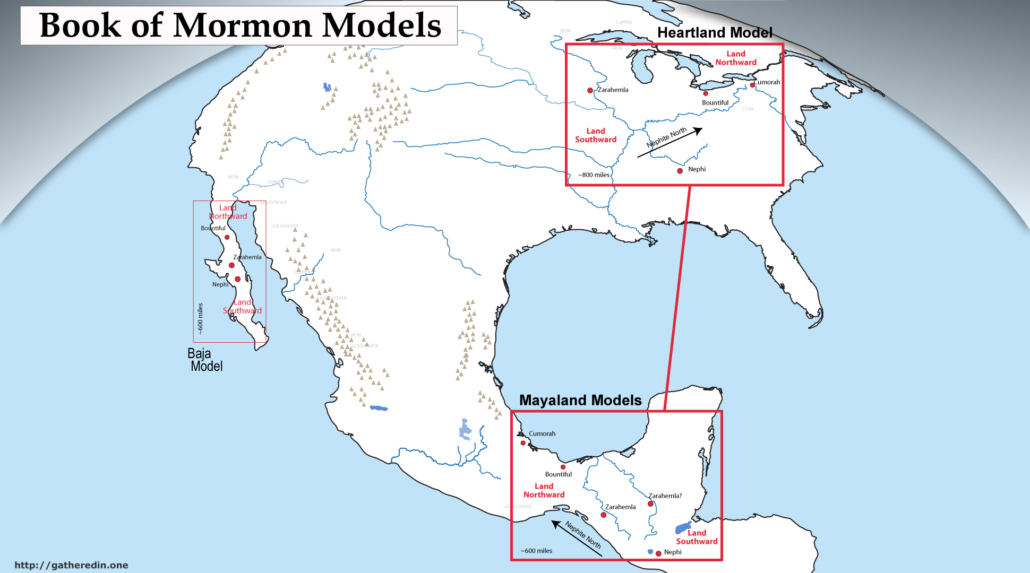
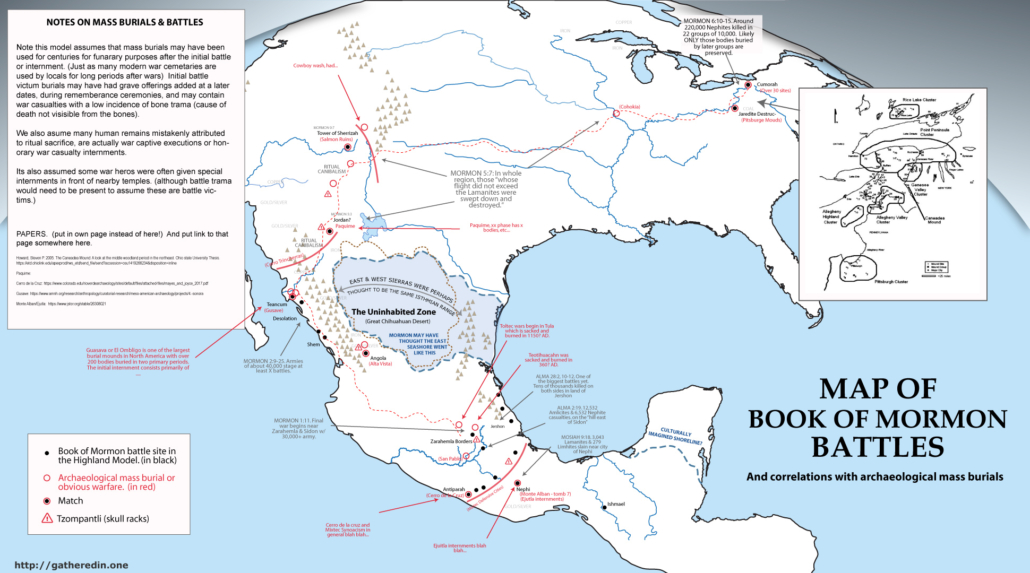
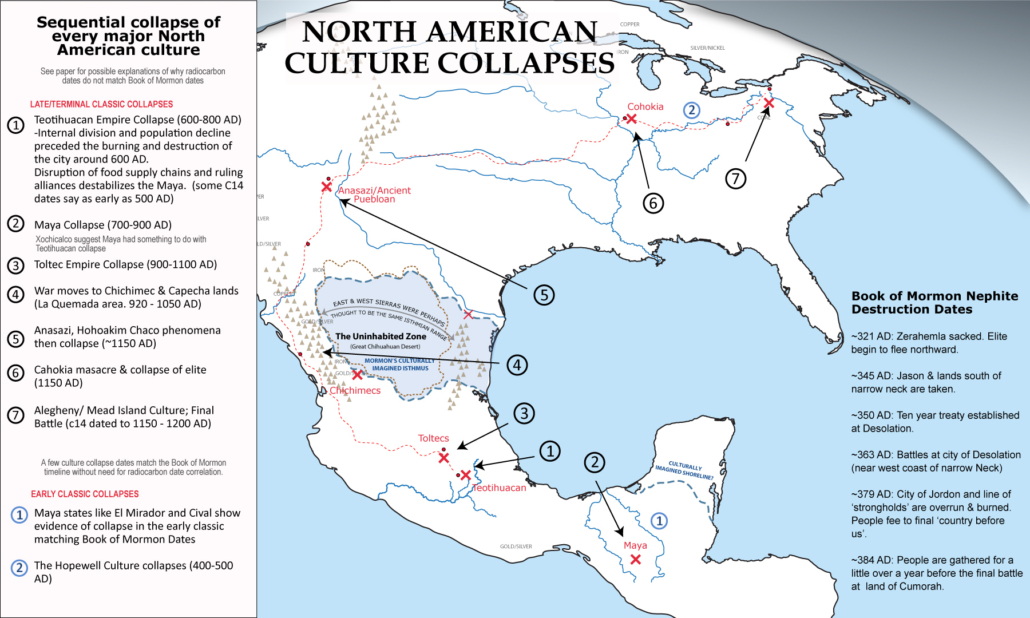

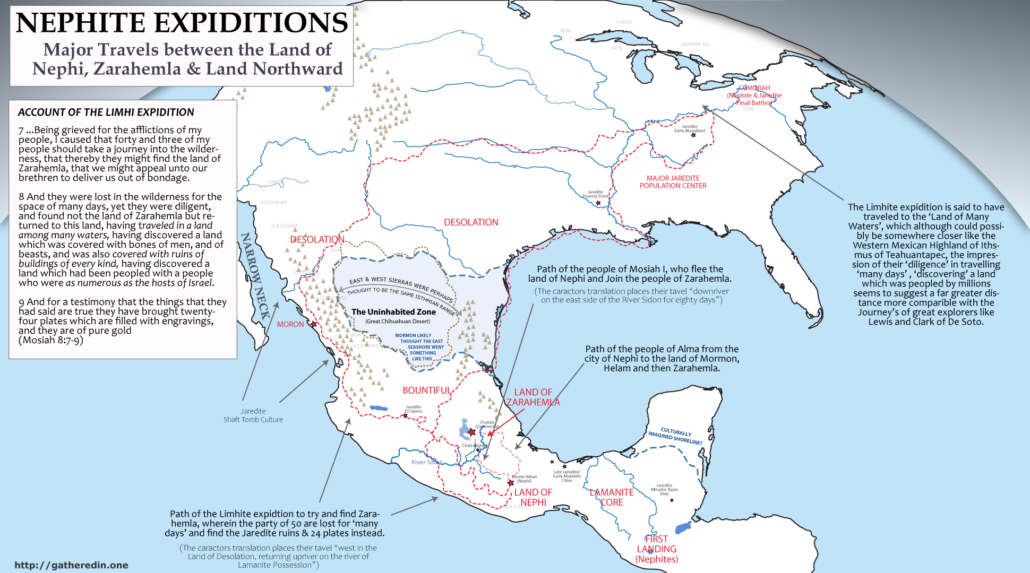
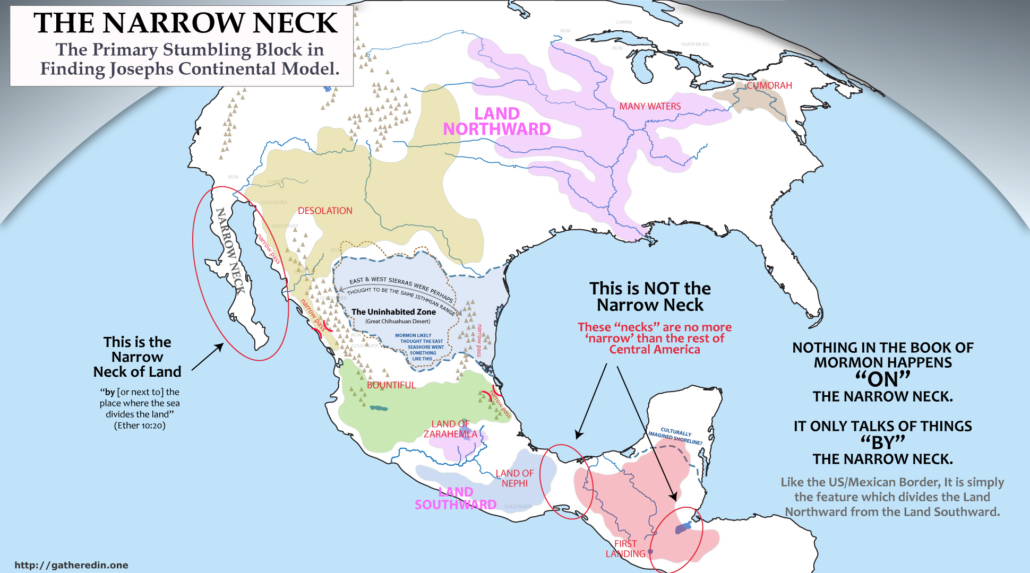
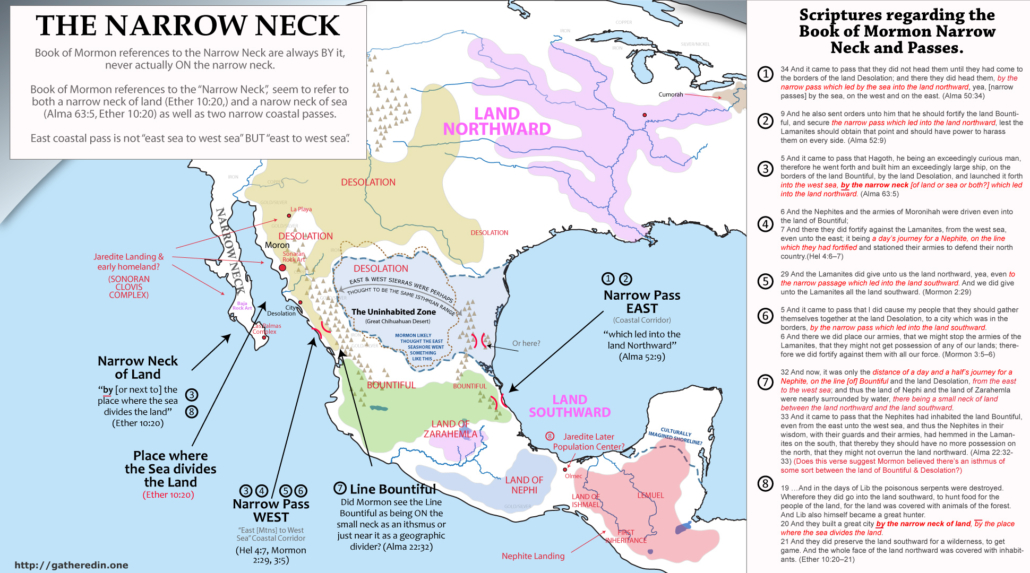
.
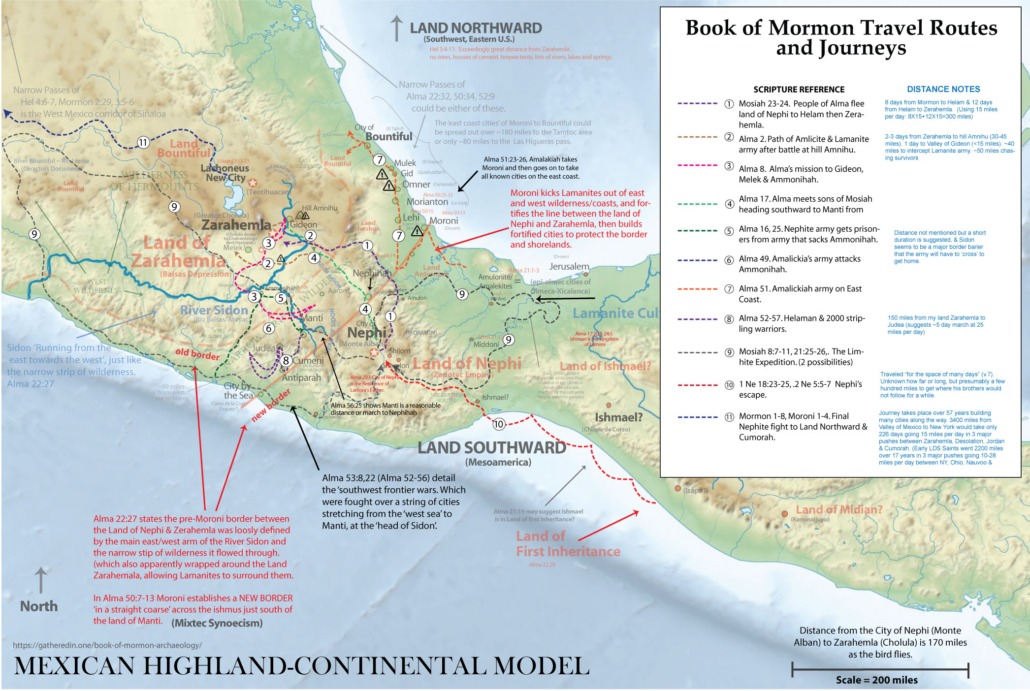
.
Introduction
This article presents the new Mexican Highland-continental model Book of Mormon Geographic correlation. With this model, essentially every culture the texts mentions end up being a major culture found by modern archaeologists. In fact, essentially all the largest North American prehistoric cultures are represented in this model of the Book of Mormon text. This unique continental model also correlates incredibly closely to the beliefs of Joseph Smith and other early LDS prophetic figures.
Far from sticking the Book of Mormon location into a small Mesoamerican or Heartland corner, our model correlates the texts most mentioned cities with the most influential Mesoamerican archaeological ruins. Zarahemla and the Nephites are correlated with arguably the largest cities and most dominate, powerful prehistoric culture on the continent — Teotihuacan/Cholula and the Mexican Highland/Balsas Basin culture. The Lamanites are correlated with what was likely the most sophisticated and populous culture in American prehistory — the Maya. The City of Nephi with its towers, priest cult and expensive public works correlates with the great Zapotec fortress of Monte Alban, which sat between the Maya (Lamanite) and Highland (Nephite) cultures. The River Sidon matches with what many consider Mexico’s most economically important & strategic water way– the Rio Balsas.
The book of Mormon’s ‘Land Northward’ stretches from the rock & cement great-houses of the ancient Puebloan peoples in the desert southwest, where Joseph Smith taught “the Nephites lost their power”, all the way through Mississippian and Hopewell peoples of the Eastern United States.
The early Jaredites end up largely corresponding to not only the first inhabitants on the continent but also the only North American culture that archaeologists have found to have coexisted with elephants and other extinct mega-fauna (Paleoindian, Clovis & Folsom cultures). They expanded to cover both Northern America and Mexico instead of just a part of the Isthmus of Tehuantepec (proto-Adena as well as Olmec & all other archaic to early formative/woodland groups). And the destruction of the Nephite culture described in the text, corresponds to the well-known collapse of essentially half the major cultures on the North American continent between the radiocarbon dates of 1050-1150 AD from Tula to West Mexico and the Anasazi/Ancient Puebloans as well as Cahokia and Cumorah (peoples of the ‘Land Northward).
Truly all the main events of the Book of Mormon have been found by archaeologists and correspond with the most notable events in North American prehistory. However, most LDS scholars have overlooked these amazing correlations because of hang-ups involving their mistaken narrow neck and radiocarbon/timeline issues which we explain in detail.
The Failure of All Other Models
LDS scholars have tried to find a convincing correlation between the Book of Mormon narrative and archaeological evidence for 150 years and yet are still squarely split between three predominate models. Why? Simply put, there is no perfect match to the geography described in the Book of Mormon. All models contain a number of substantial problems between the text and available archaeological evidence.
In the following chapter we provide overwhelming evidence that most early geographers had rudimentary knowledge of shorelines in the places where few people ventured. We suggest that because of the impassible nature of the Great Salado Basin & Chihuahua Desert, Mormon similarly believed the East & West Sierra Madre Mountain Ranges to be the same single range. [shortly discuss the fact that only ONE of the seven references seems to suggest this, the others suggest Baja as the narrow neck] Mistaking the narrow east & west Mexico travel corridors for another ‘narrow neck of land’ or “narrow pass” like many of the others found in Central America.
We also devote a chapter to explaining why the radiocarbon techniques used to date the North American post-classic cultural collapses do not seem to correspond with the Book of Mormon dates. [reword. They might, its just not nearly as good a match as the post classic collapse, which matches in EVERY regard]. Even though the evidence of cultures, populations, settlement patterns, war, cannibalism, cultural destruction and abandonment and desolation stretching all the way from the Toltec and Maya through the Anasazi lands and Cahokia seem to match amazingly with what is described in the book of Mormon text. For this discrepancy we give two possible explanations. One being skewed radiocarbon dates caused by a type of marine reservoir effect of excess carbon 14 introduced by a massive comet and CME hitting the Pacific Ocean at the time of Christ (much like the similar but smaller documented 774 AD event). And the other being a rather convincing argument that there were actually two large comet impacts in the Pacific Ocean which corresponded with two separate Quetzalcoatl figures in the Nephite (and Aztec) annals. One at the death of Christ and one at 774 AD which combined with a few other calendrical issues, caused Mormon to mistakenly believe he lived around 400 years after the death of Christ, when in fact he actually lived 400 years after 774 AD and Lord Quetzalcoatl the ruler of _____. [express that this is the far more convincing possibility, although we should hold space for both camps of thought.]
This model is different than most others in that it focuses on correlating cultures, events and actual archaeological cities instead of focusing so much on radiocarbon dates and the narrow neck. We also show the significance of considering the Book of Mormon a ‘channeling’ instead of a ‘translation’. Channeling, or the act or practice of a mystic somehow ‘seeing’ events across space and time and/or serving as a medium through which an angel or spirit purportedly communicates with living persons was very common during the Second Great awakening, and far better explains the anachronisms and issues which exist in the Book of Mormon text. By looking at the text as a more fluid product of visionary ability instead of a literal translation, amazing correlations become apparent. Book of Mormon events begin to align with all the major cultural movements & conflicts found in North American prehistory, and a [there’s complexities that I may or may not want to mention here of Medieval/Norman influence being the primary lens through which BOM translation occurred].
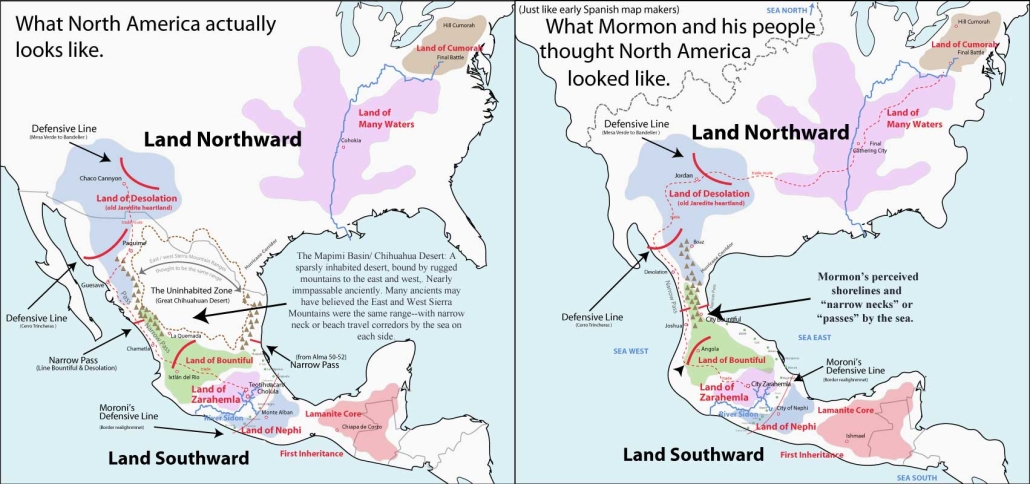
Illustration depicting the actual geography of North America versus what the ancient authors of the Book of Mormon may have thought the geography looked like. {Change defense line to names of cultures/bom peoples with dates of existence.}
The Continental Model of Joseph Smith
From the available documented evidence, it is apparent Joseph held a continental view of Book of Mormon Geography. Quotes by Joseph Smith or statements attributed to him point to a belief in four major areas of Book of Mormon happenings.
- He believed the Lehites to have landed in South America (refs)
- He believed them to have travelled to Central America to settle (with cities like Zarahemla being there). (refs)
- He believed them to have ‘lost their power’ (i.e. the Land Desolation) in the U.S. Southwest. (refs)
- He believed Cumorah and the final battle to be in New York, and much of North America to be the Book of Mormon ‘Land Northward’. (refs)
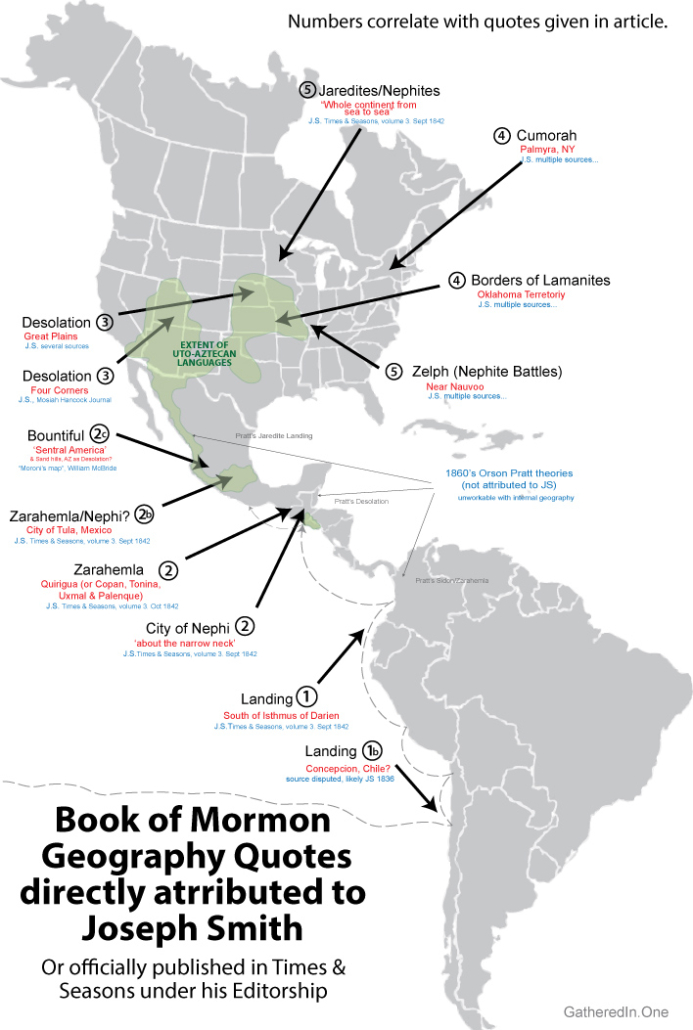
-quote of landing in Chile or a bit south of the isthmus of Darian
-quote of Land of Lehi (lands of Nephi, Zarahemla and Bountiful) was in Mesoamerica
-quote of Desolation being the Desert Southwest (ancient Puebloan cultures)
-quote of Cumorah and final battle being in New York.
Use my article AND the farms ones. http://mormonuniversalism.com/449/joseph-smith-quotes-on-book-of-mormon-geography/, https://www.fairmormon.org/answers/Book_of_Mormon/Geography/Statements/Nineteenth_century/Joseph_Smith%27s_lifetime_1829-1840, https://www.fairmormon.org/blog/2010/04/02/book-of-mormon-geography-in-joseph-smiths-day
An Internal Model
Go through and do a one-page summary of needed internal model aspects. Get from intro to my already done internal model web article.
[pic of internal model]The Narrow Neck
A study of ancient maps and geographies suggests that modern LDS Scholars have expected too much from ancient Book of Mormon authors by supposing pre-Columbian cultures had a modern understanding of continental geography and shorelines. Indeed, although many ancients understood well the spatial relationships for populated places, or places they had been, the understanding of uninhabited wildernesses and continental shorelines seems to have been very poor among cultures without widespread use of boats containing some type of nautical navigation technology.
Our model proposes that much like Sabastian Munster’s early map of the New World, Book of Mormon authors seemed to have thought there to be another ‘narrow neck’ between the narrow coastal ‘passes’ of Northern Mexico. A misunderstanding likely caused by a belief that the Eastern and Western Sierra Madre mountain ranges were one and the same range. An easy mistake to make given their lack of travel through the nearly impenetrable and uninhabited Mapimi Basin of the Chihuahua Desert. Indeed historical texts show that essentially ALL travel & trade instead, occurred along the ‘narrow passes’ between the coasts and the steep mountain ranges, with only a few sparsely inhabited mining communities existing in the Deserts of the northern interior.
Note that Cabeza De Vaca, after being marooned in the New World and living with the Natives for years in regions all the way from Florida to West Mexico, still though late in life that northern California somehow shared the continent with Asia. He describes the mental geography he had created in his mind after living with the natives thusly.
[Pictures of the coastal passes from my 3d map with exaggeration.]These people [Southwest Natives] … must come from that part of Greater India, the coast of which lies to the west of this country, for they could have come down from that country, crossing the mountain chains and following down the river… As they multiplied, they have kept on making settlements until they lost the river when it buried itself underground, its course being in the direction of Florida. It [the Rio Grande] comes down from the northeast, where they [Coronado’s army] could certainly have found signs of villages. He [Coronado] preferred, however, to follow the reports of the Turk, but it would have been better to cross the mountains where this river rises. I believe they would have found traces of riches and would have reached the lands from which these people started, which from its location is on the edge of Greater India, although the region is neither known nor understood, because from the trend of the coast it appears that the land between Norway and China is very far up [in the North/Arctic]. The country from sea to sea is very wide, judging from the location of both coasts, as well as from what Captain Villalobos discovered when he went in search of China by the sea to the west, and from what has been discovered on the North Sea concerning the trend of the coast of Florida toward the Bacallaos, up toward Norway.
(The Narrative of Alvara Nunuz Cabeza de Vaca. Ch 6. v. 3)
REWRITE THIS ENTIRELY… The problem, of course, is that these overwhelmingly obvious correlations do not work with Mormon’s ‘narrow neck’, which is said to be north of Zarahemla and Bountiful. (As well as a few radiocarbon dating issues we cover in another section). Because of this, most serious LDS scholars have looked south of the isthmus of Teohuantepec, isthmus of Guatemala, or isthmus of Panama. A correlation which forces one to ignore EVERY major culture in North America apart from the Maya (the Lamanite core in our model). But of course, because essentially ALL the greatest Mayan cities are east of the possible candidates for the River Sidon, as well as significant issues with Moroni’s ‘east sea cities’ (ref), these models must throw out even the largest and most influential Mayan cities from any possible correlation with the Book of Mormon. With our continental model, essentially EVERY significant ancient culture in the North American continent, as well as their largest cities, are part of the Book of Mormon narrative. From the Maya to the Zapotec, Huestec to Mixtec, Teotihuacan and the Mexican Highland to the Toltec and Chichimec to the Ancient Puebloan/Anasazi to the Hopewell. The list goes on and on, of overwhelming correlations between the Book of Mormon text and archaeological ruins, geographic relationships, language relationships, Native American mythologies, settlement patters and more.
Arrival of the Jaredites
Start by talking about how it’s a channeling of a channeling.
The Book of Mormon narrative explains that the Jaredite civilization was the first culture to inhabit North America and the only to coexist with elephants and other megafauna early in their history. (Ether 9:19, Note that for the early Jaredites, these megafauna were ‘especially useful for the food of man’.) It further states that a great dearth or climatological shift caused massive fauna migrations which the people followed, hunting them to extinction. (Ether 9:30,34)
Shouldn’t it be obvious that the only plausible archaeological correlation for the pre-dearth Jaredites is with the North American Paleo-Indians? (C14 dated from between 14,000BC to 7000BC) These were the first inhabitants of North America, and are the only North American cultures to interact with elephants (Mammoth and Mastodon). There are also many other correlations between these cultures but none have seen the similarities because of the difference between carbon dates obtained for these cultures and the dates inferred from the scriptural record.
The cultural center for two of the most notable Paleo-Indian peoples (the Clovis & Folsom) are located in the North American Southwest, which as both the Book of Mormon and our model show, matches with the Nephite land of Desolation.
Although modern scientific consensus is that these groups migrated from Asia to North America across the bearing straights, we believe that the Book of Mormon account of ship travel is equally plausible (given the 40,000 BC in-habitation of Australia). Diverse groups of ‘Jaredites’ spread out to cover North & South America, and we propose also migrating back into Siberia, Asia and parts of Europe.
We also suggest that the Jaredite account, like the Book of Mormon itself, was ‘channeled’ by the ancient author Alma from some ancient record which acted as a talisman or prop. In doing so, the ancient author projected his own biases and beliefs on the Jaredite record in the same way Joseph would have later done with the ‘translation’ (channeling) of the Book of Mormon.
Map of known ancient migrations, overlaid with possible path of Jaredite migration.
Omer and the Bull Brook Complex
As the early Book of Mormon ‘pre-dearth’ period in American prehistory was coming to a close, a small group of families left the core area and settled ‘by the seashore’ directly east of the hill Cumorah (Ether 9:1–13). The group of sites, in and around northeastern Massachusetts, are called the Bull Brook Complex by archaeologists. Clovis points found at several of the sites tie it to the Southwest.
Building on excavations by D.S. Byers in the mid-50s, archaeological societies in the Northeast have pieced together the history of the Bull Brook Complex. Their findings and subsequent analysis have shown the interactions of a system of organized, interdependent groups with specialized work force networks. It is recognized as containing the highest level of social structure in America at that time, which would be expected in a ‘refugee camp’ of the royal household.
As Moroni attests, the next archaeological period saw the rise of a richer and more diversified culture / . The Plano and Early Eastern Archaic Cultures fanned across the continent (S/H: around 1600-1200 BC; A/C: around 8500-6000 BC). Scientists have found the full spectrum of plants and animals corresponding to the days of Emer. See animals in the book of Mormon
Post-Dearth Jaredite Culture (Lib’s Empire & ____)
Moroni’s next exposition on culture comes in the days of Lib (Ether 10:18–28), who is based in the Land Northward [Adena culture of the Ohio Valley] but builds a southern outpost at a ‘Narrow Neck’ [Olmec culture of Mexico]. My corresponding period is labeled by archaeologists as the Middle and Late Archaic. Often indistinguishable from one another, these two cultural periods represent a major advancement over the preceding culture. Again the culture spread across North America from coast to coast. There were villages, agriculture, and widespread trade networks. South of the narrow neck, in the Mexican highland and beyond, the only inhabitants we find are organized hunting parties, which ‘coincidentally’ brought spear points of North American manufacture and style.
Scientists recognize metallurgy from this time period, and copper is the most common metal found. Many fine textiles have also survived from this period. Moroni says they made ‘all manner of tools to till the earth, both to plow and to sow, to reap and to hoe, and also to thrash’. He also says they had, ‘all manner of tools with which they did work their beasts’ (Ether 10:26–27). Most of the tools on this list have been found by archaeologists at sites dating to the Middle and Late Archaic. New weapons were also invented and manufactured, although archaeologists currently view them only as hunting weapons. Another major industry of the Jaredites was wood exploitation. A huge assortment of woodworking tools has been found at archaic period sites across the Nation.
This ‘southern outpost’ built in Mexico, which grew into the Olmec culture, to facilitate trade between the Atlantic and Pacific oceans even captured some trade from Asia. The ‘Jade Masks’ of the Olmec have obvious similarities and cultured ties to Chinese art and Jade work. We believe these ‘Jade Masks’ came from Chinese trade ships and will one day be conclusively tied to Chinese jade mines, and the ‘jade emperor’, through isotope studies. Archaeologists will slowly come to realize that ancient seafaring and trade was more widespread than currently thought.
Olmec & the Fall of the Jaredites
Many Book of Mormon model’s attempt to match the Olmec with the Jaredites. In my model the correlation is more complex with the Olmec matching only the southernmost branch of the late Jaredite civilization; San Lorenzo corresponding to the ‘great city’ which Ether 10:19–28 says Lib built by the narrow neck. The culture that rose from Lib’s city is separate from the Jaredite heartland in the Land of Desolation [Southwest U.S.] as well as Lib’s capital which was likely in the Adena heartland of the Ohio valley (thus the similarities between Adena & Olmec mound structures). The ‘narrow neck’ mentioned in Ether is different from the defensive ‘narrow pass’ between Bountiful and Desolation mentioned by Mormon elsewhere in the Book of Mormon. There is no need for any ‘two Cumorah’ theory and most of the traditional issues with an Olmec/Jaredite correlation are removed.
From as early as the time of Nephi and Jacob, the Nephites of San Jose Mogote [city of Nephi] heavily influence the Olmec. As the Jaredite civilization collapses around 300 BC with the exodus of the elite to join the great Adena war, the new Zapotec/Olmec mix is called Epi-Olmec and is largely defined by the spread of the new Nephite (Zapotec) writing system. Before the Olmec collapse, their influence is seen readily in the early colonies of Izape and Chiapa de Corzo (Lamanite core), San Jose Migote (city of Nephi) and Mexican Highland (Mulekite core). In fact the early mixture of Nephite outliers and Lamanites with the epi-Olmecs sets the stage for the Book of Mormon’s Zoramites, Amalekites, Amulonites and other Nephite dissenters who effectually take control of remnant Olmec cities like Tres Zapotes after the Olmec collapse.
The Amulonite priests (Zapotec/epi-Olmec group of Oaxaca) were likely responsible for appointing teachers who began to train the Maya [Lamanites] in the same language and learning of Zapotec [Lemhites] and Mexican highland people [the Nephites]. With this new education the Maya began to prosper and make many technological advances. The sparsely-populated Mayan lands were soon covered with huge temples and city-centers with art and architecture reminiscent of the Zapotec and epi-Olmec style.
Colonial Arrivals & The Rise of the ‘Epi-Olmec’
In our article on the scattering of Israel, we detail how the Babylonian empire initiated a global colonial movement, matching closely with the European Colonial era 2000 years later.
In our model, colonies started in South America, the Zapotec of San Jose Migote [Nephites], and the Otomangue-speaking people of the Mexican highland [the Mulekites], who brought new and unique pottery & practices to the Americas; in each culture the pottery was already well-developed even at the earliest sites. (These new cultures can often be associated with skewed or erratic carbon dates going as early as 1500-4000 BC) The architecture and burial customs of these groups can easily be tied to the Old World. (Although nothing convincing enough has yet to be found to overturn the predominate belief of American/Eurasian no contact.) Square waddle and daub homes with storage pits in the floor dotted their lands. Their temples and public buildings are extremely similar to those of Egypt and Israel. Subfloor burials and burial positions also match those of the Middle East.
The Land of Nephi
San Jose Migote and the appearance of the 2 room temple and ‘men’s houses’. Also new religion. Find the article on this. The development of a valley separation.
The Move to Zarahemla
At the dawn of the formative period there were several major demographic shifts which set the stage for the developing cultures. First, King Mosiah I and his people left the Land of Nephi [San Jose Migote/Monte Alban] and traveled to early Zarahemla [central Mexico, Likely Cholula at that time] to join the Mulekites (S/H: around 200 BC; A/C: around 1400 BC). This is seen archaeologically as an influx of Mixe-zoquean culture brings new advances to central Mexico, and public buildings begin to appear in the larger villages.
Archeological evidence in the Valley of Mexico also shows the appearance of epi-Olmec influence in sites such as Tlatilco and Tlapacoya. In our research, the early Nephite Zapotecs of Oaxaca effectively merge with the late Olmec [left over Jaredites from Great City of Ether 10:20] and are thus outlier Nephite peoples from before the move to Zarahemla, the late epi-Olmec may also be associated with the Amulonites who enslave the people of Limhi & Alma and build a short lived empire by teaching and exploiting the Lamanites (early Maya).
Zeniff Rebuilds Monte Alban, the City of Nephi
Back in San Jose Mogote [the city of Nephi], the city falls from its preeminence as the ruling elite leave [Moroni I] and those remaining are almost indistinguishable from their epi-Olmec trading partners. Shortly, however, high culture returned to the valley as Zeniff and his people arrive and begin to build anew a fortified city with public buildings and towers overlooking its neighbors [Monte Alban].
The new inhabitants of Monte Alban [people of Zeniff] were an elitist group which maintains strong ties to the Mexican Highland [Zarahemla] for hundreds of years afterward. Initially their culture was very similar to that of central Mexico (from which they had come), but the similarities decreased as time went on and they (the people of Zeniff, now led by King Noah) became extravagant in their prosperity. Lavishness dominates the architecture and material culture of this period. With the influence of Alma the younger, and his companions, and their conversion of Lamoni and his Father (and the expulsion of their loyalists who were likely centered in Mitla), the land eventually becomes a strong trading partner and vassal to Teotihuacan [Zarahemla].
Robert Zeitlin in his book “Questions about Zapotec Imperialism in Formative Period Mesoamerica highlights the research and archaeological evidence that Monte Alban was the center of an early conquest oriented empire. He says, “Recent Archaeological and epigraphic research suggests the existence of what could be Mesoamerica’s first conquest state centered at Monte Alban” (read this talk about how Nephi started the Empire, but when fighting with Mitla got to great they fled. However Monte Alban
Questions about Zapotec Imperialism in Formative Period Mesoamerica: https://www.jstor.org/stable/281646
The emergence of the Zapotec Military State
Give a bunch of quotes and data here.
The evidence for the emergence of the Zapotec military state in the later formative is an AMAZING match to what we expect from the Book of Mormon text after Lemhi abandons
Make a time line chart of events of city of Nephi from first to second abandonment and reoccupation by Lamanites.
See Military Expansion outside the Valley of Oaxaca: (C14 dates on burning of monte alban & surrounding fortresses) https://europepmc.org/article/PMC/208841
Alma 22’s General Geography of Book of Mormon Lands
In Alma 22, we are given perhaps the most comprehensive general overview of Book of Mormon geography…. (he wants us to find it? Go over piece by pieace.
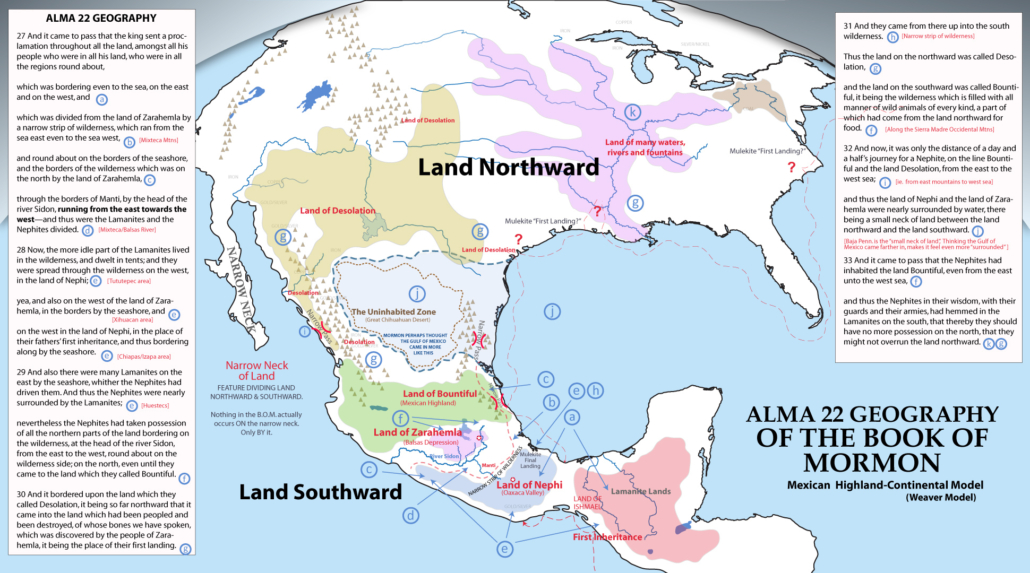
Captain Moroni: Fortifying the Mexican Highland & Mixtec Synoecism
Outline: Although scattered walled or fortified cities occur throughout the mayanlands, perhaps no where in Mesoamerica was it as ubiquitous as the Mixtec & Huestec lands. The string of fortified cities matches perfectly with the ‘backwards L’ laid out in Book of Mormon’s internal geography. But perhaps more impressive is the way that archaeological digs shows these fortifications came about. Authors like x,y & z suggest that warfare likely caused hundreds of hamlets in the Mixtec regions to consolidate into walled hilltop fortresses during the later formative precisely when the book of Mormon says… (get archawolocical quotes and bom quotes)
Mixtec Highland cities in our Manti region like Monte Negro, Huamelupan, Cerro Jazmin, Yucuita, all consolidate around the same time in the late formative. Also cities of the lower Verde Valley like Rio Viejo, Cerro de la Cruz, Yugue and Cerro de la Virgen and San Francisco de Arriba. (add map of all these cities. In the west Cerro de las Mesas was built during this time and is almost certainly associated with the city of Moroni (which was inundated at the death of Christ). La Coyotera & Quiotepec Fortress in the Teuacahn Valley are almost certainly Nephihah and date to right around the time of Moroni. These cities changed hands multiple times and were likely held by the Zapotec/Lamanite regime of Monte Alban more often than the Nephites of Cholula.
These two great nations, the Nephites on the Mexican Plateau and the Lamanites [Maya] in Southern Mexico, Guatemala and Yucatan, began to experience greater conflicts. Foreseeing the coming challenges, Captain Moroni prepared his people and their lands. First, the weak lands were fortified and the southern frontier was strengthened. Hilltop fortifications began to dot southern Mexico in Veracruz, Oaxaca, and Guerrero. Great urban fortresses were created. No wonder Mormon venerated the leadership, courage and vision of Captain Moroni and the manner in which he prepared his people for war.
After Amalickiah’s first attack, a second phase of construction was begun in which fortified cities and hilltop fortresses were built throughout the land of Zarahemla which appears to have stretched from Oaxaca to Jalisco and from southwestern Michoacán to northern Veracruz. Also, the Book of Mormon records Moroni pushing the Lamanites out of the east wilderness and on the west, then building new cities in these areas in order to create a more defensible border. Excavations in southern and western Oaxaca and Guerrero, as well as central Veracruz are now showing such movements of peoples and the construction of new large defensive cities and fortresses.
During the time that fortifications were being built in the Mexican highland, a massive weapons production industry commenced throughout Mesoamerica, both in the Mexican Highland [Zarahemla] and in Maya [Lamanite] lands. To accommodate these war preparations, the peoples of the Mexican Highland [Nephites] made major breakthroughs in agriculture and built massive irrigation systems. From that time forward, urbanization and trade specialization, with accompanying prosperity, enveloped the Nephite lands.
The great war of Moroni’s time, and the wars that followed, are seen archaeologically in demographic and cultural movements of this time period, and in numerous monuments depicting warriors and captives in both Highland Mexico and Maya lands. The Lamanites displaced and jumbled the Nephites numerous times. There was also a great cultural mixing when groups of Lamanites converted to the Nephite religion and went to live among the Nephites, and also when groups became captives. Cities experienced occasional upheavals, but most of them changed hands without noticeable ruin.
War on the east & southern fronts
Add section. Map movements
References.
The People of Ammon in Jershon
Book of Mormon says the people of Ammon were mostly women. After the death of most the men among Ammon’s converts the remaining people buried their swords and fled for refuge among the Nephites. After travelling to Zarahemla they were given the land of Jershon, the location of which was said to be,
…on the east by the sea, which joins the land Bountiful, which is on the south of the land Bountiful; and this land Jershon is the land which we will give unto our brethren for an inheritance. (Alma 27:22)
Later when the armies of Zoramites prepare to battle the people of Ammon (because they had given refuge to the Zoramites who were expelled), the people of Ammon flee “over into the land of Melek” (Alma 35:13).
Our model places the eastern coast cities of Bountiful, Melek, Moroni, Aaron, Nephihah and Jershon on the east Coast of Mexico stretching somewhere between Tampico on the north and Veracruz (or more likely El Tajin) on the south. Many fortified settlements, castles and towers are found within the small stretch of coastline. Among them lies a coincidental correlation between the city of Tamtoc (aka Tamtok) and the people of Ammon.
Although Tamtoc reached its zenith in the late classic, archaeological evidence has determined the city was founded as early as 600 BC by Olmec (Jaredite) peoples. If a correlation to the people of Ammon is to be made, better dating of the mostly female remains would need to be found to fit into a window of closer to 100BC to 200AD. The latter date assuming that the early Book of Mormon women of this community started a legacy of feminine predominance which lasted at least a few centuries after its establishment.
Approximate routes and dates of the proto-Huastec and other Maya-speaking groups
One of the characteristics that distinguish Tamtoc is the remarkable female presence. To date, 90% of the burials discovered there are of women. Furthermore, they are represented in most of the clay and ceramic figurines found here and that are thought to have a high rank in the social division of the community. The sites iconography touts a sculpture of a “priestess” (dated to as early as 600 BC) and “the Scarified Woman or Venus of Tamtoc”, which has been interpreted as glorifying…
Perhaps one of the most striking correlations between this city and the Book of Mormon narrative is the linguistic evidence which suggests that the language of the “Huestec” culture which permeated Tamtoc came from the Putin Maya region of Oaxaca and Southern Mexico (our land of First Inheritance). ref.
Lachoneous and the Founding of Teotihuacan
Just before the time of Christ, the combined guerrilla forces of ‘The Gadianton Robbers’ became so numerous as to warrant an unprecedented sociological experiment. All the people of Nephi temporarily abandoned their cities and moved to a new area in ‘The Land of Zarahemla’ (3 Ne 3:13–23). In our model, the urban city built for these immigrants was the great city of Teotihuacan. The old city of Zarahemla (likely Cholula or Cuicuilco) was too exposed and near the forests where Guerrilla fighters could hide, as well as being threatened by volcanic eruptions. So with hundreds of thousands of refugees and immigrants, what was likely the largest pre-planned city in the world was born. In the middle of a large open defensible valley, Teotihuacan was built with the refugee cultures in mind, with defined quarters for each major culture. The Zapotec from the land of Nephi, the Mixtecs from Gideon, and the Totonac and epi-Olmec from the lands of Melek and Jershon, and even Nahua peoples from the land of Desolation and fleeing Lamanites from the Mayan lands.
The city contains some of the largest structures on earth, with the pyramid of the Sun and Moon rivaling the Great pyramids of Egypt. At its zenith a hundred or so years after the time of Christ there were likely up to 250,000 inhabitants in the 11+ square miles urban area, not counting the many, many satellite communities.
The city would soon come to be the de-facto political and religious capital of Mesoamerica, holding rule and influence of peoples from the Lamanites of Guatemala to Anasazi of Arizona and New Mexico (land of Desolation).
Cataclysms at the Coming of Christ
The Book of Mormon suggests a global reaching cataclysm at the death of Christ, causing large scale destructions to North America and “the isles of the sea” (3 Nephi 8-9, 1 Ne. 19:10–13, Hel 14:20–24, 1 Ne. 19:10) which are contrasted with more the minor phenomena of an earthquake and three hours of darkness in Israel and Eurasia at the same time in the Bible (Matt 27:51–53, Mark 15:33, see also Phlegon, Thallus, Africanus and Tertullian).
Many authors have shown how some of the destructions described in 3 Nephi 8-10 in the Book of Mormon could be attributed to a large volcanic eruption. However, the shear extent of cataclysms in MULITIPLE lands seemingly involved not only volcanic phenomena such as earthquakes, lightning, darkness, tempests and fire from heaven. But also regional tectonic and coastal changes where ‘cites… had been sunk, and waters came up in the stead thereof [which]… could not be renewed” (4 Ne 1:9). As also unprecedented tectonic changes to some degree which caused the “whole face of the land [to be] changed” (3 Ne 8:12), wherein the “highways were broken up” (v.13) and “many notable cities” were sunk, burned, shaken to the ground and left desolate (v14), with mountains and valleys left in their place (Hel 8:23). In one instance the texts states that the “earth was carried up upon the city… that in [its] place there became a great mountain” (3 Ne 11:10). This language is quite different from what one might expect from landslides or volcanic ash flows where earth would be carried down upon a city.
Such overwhelming natural disaster reminds one of the mythical tales of destruction common in historical literature and are nearly ubiquitous in Mesoamerican codices involving their gods and cultural heroes (ref). Reasonably, one must accept the possibility that Book of Mormon authors used hyperbole and mythical embellishment in their records to explain the destructions which preceded the coming of Christ to America.
If, however, we would seek to take the Book of Mormon text at face value and propose a literal, unembellished nature to these destructions, we must become inventive in our theories and turn to what we know of astronomical physics to suggest a few possibilities. Many authors have suggested a simple volcanic eruption, which of course falls short of the kind of widespread global darkness, volcanic, atmospheric and tectonic destruction described in the text. Instead, we must find a mechanism which could cause global darkness and seismic activity and widespread volcanism, yet affecting one hemisphere far greater than the other—and likely a correlation or relationship to a ‘new star’ appearing some 30 years earlier.
The most likely suspect would be some type of pulsar or large supernova at Christ’s birth, which in turn knocked local cosmic debris into the path of earth causing an asteroid impact to hit the Pacific Ocean some distance off the West Coast of Northern Mexico just after His death. This atmospheric and seismic waves from this impact (as well as a possible accompanying CME from solar impacts) then was responsible for the simultaneous atmospheric and tectonic cataclysms mentioned in the Book of Mormon, ancient Mesoamerican codices the Bible and early Christian historians (Phlegon, Thallus, Africanus and Tertullian).
The effects of such an event have been modeled to show that it could indeed account for many of the destructions described in the Book of Mormon. Galen Gisler and scientist at Los Alamos laboratories have created a visualization which shows.
-supernova, pulsar, asteroid, MOON hit, and tidal effect on both water & land/tectonic shift. Use this study/visualization by Galen Gisler at LANL & los Alamos … awesome! https://gizmodo.com/heres-what-would-happen-if-a-giant-asteroid-struck-the-1790084340 https://www.youtube.com/watch?v=95z0qRNFFxs use this in your videos and presentations! Make an image, to put in book (with notes explaining the tsunami, seismic waves, atmospheric compression waves, heat wave and water vapor. Also radiocarbon introduction & production in ocean & atmosphere.
Not hard to believe given Meteor Crater Arizona (dated to 50,000 BP) and Sirente crater Italy, dated to 412 AD, or the Tunguska event
2 Simulation of an asteroid impact over the ocean done by Galen Gisler and scientist at Los Alamos labs. Finding show that tsunami danger is not as large as before suspected, but significant danger exists from seismic waves (if contact is made with ocean floor), atmospheric compression waves, atmospheric heat wave and ejected water vapor. Weather disruption is inevitable. Our model also theorize substantial radiocarbon production and a lasting marine reservoir exchange downwind from the affected ocean water.
-be sure to hit the idea that the pre-Christ land of desolation would have been DESTROYED by the west coast tidal waves in the scenario. Also that it would affect radiocarbon dates…
[You need to make an illustration showing radiocarbon spike of BOTH the atmosphere and ocean area, and show on the graph lines correlation what 4 points on the line would do to correlated dates—on both the up and down (atmospheric up would be instantaneous, marine carbon exchange would be gradual up and down. And point out that nuc tests increased CO14 100%! Even a 20% increase would mean a date adjustment of ___ years. (calculate it). Put it next to the graph of what nuclear testing did. Note its different that marine reservoir effect, which has to do with eating marine animals, the marine exchange is when high atmospheric levels are absorbed into surface waters (and worked deeper), and then recursively contaminate atmospheric carbon levels for possibly hundreds of years even after the atmospheric levels have mixed back to normal (a process only taking 100 years or so, as seen with 20th century atmospheric nuclear testing)]WORK IN? In our model, we put forward two theories to explain the cataclysms at the death of Christ mentioned in the text. The first involves a massive astronomical event such as a supernova or pulsar (seen as a ‘new star’) began a chain reaction of plasma and debris which reached earth around 34 AD. This massive plasma stream and debris in turn caused meteorites, as well as a possible impact large enough to cause very slight changes in the earth’s angular momentum (see nutation or ‘chandler wobble’) which was responsible for driving a pulse of increased flex and subduction pressure on the Pacific, Cocos and Nazca Plates at the time of Christ. This minor tectonic pulse event initiated an unprecedented earthquake, widespread volcanism, orogenic movement and thrusting which were recorded in the Book of Mormon as regional destructions in both their land Northward and Southward.
Radiocarbon Dates & The Mayan Calendar
OULINE OF SECTION
-two possibilities of why things don’t line up. ONE is radiocarbon dates are wrong. TWO is that Mormon & moroni made a mistake in their timeline. There is good evidence of both.
-The dates of ‘record keepers’, in 4 Nephi/Mormon 1 would require each person to live to preposterously old ages; and moreso, to sire children at absurdly old ages. Note that about 110 years after Christ’s coming Nephi gives the record to his son “Amos” (4 Ne 1:19–21), who keeps it for 84 years before dying in 194 AD! Since we know Nephi was old enough to take charge of the Church at Christ’s coming we can suppose he was between 25-40 at Christ’s coming in 34 AD. This means that he would have had to been at least 100 years old when he gave the records to his young son Amos who then lives at least another 84 years himself before dying. So if Amos was 12-20 when he got the records, Nephi would have had to father him at the ripe old age of at least 80-88 years of age!
This gets worse in the next generation as Mormon writes in 4 Ne 1:47 that Amos dies in 308 AD and gives the record to his brother Ammaron. But this doesn’t work at all since 4 Ne. 1:20 told us Amos kept the record 84 years (after about 110 AD) which should put us around 194 AD when Amos gives up the record and dies. So we have at least 114 years unaccounted for. Because of this discrepancy, some have speculated that Amos had a son which the text does not mention, who was also named Amos, so Mormon is simply talking about 2 different Amos’s. However, even this theory would require Amos I having Amos II at over 100 years old! This leads us to draw a more natural conclusion that there was simply a “break” in the record which Mormon glosses over in order to make sense of the “400 year prophesy” and his belief that he lived around 400 years after Christ.
However, what if there were TWO Quetzalcoatl’s? Many archaeologists and Mesoamerican historians believe that a King took over the title Lord Quetzalcoatl nearly 700 years after Ixtloltalx tells us that the true Lord Quetzalcoatl came…. finish
Our model suggests two possible reasons for why the dates for the collapse of the continent doesn’t line up….
[MAKE AN ILLUSTRATION OF THE SIMILARITIES….]-Both have a start date known to be somewhere around 3-4,000 BC. (the Hebrew calendar ‘Ano Mundi’ is currently believed to be 7 October 3761 BCE, although some ancient scholar placed it as early as 4500? BC. The Mayan calendar also has an ano mundi start date. I originally had several theorized start dates, ranging from xxx to yyyy (ref). With radiocarbon dating (ref) it was placed at 3114 BCE, but by putting it closer to the accepted ‘Hebrew Calendar’s start date of 3761 BCE, the Stella dates seem to ‘coincidentally’ ALL fall into the window of Book of Mormon history (reword).
-They both use a type of ‘Jubilee’ year of remarkably similar duration. 49/50 years in the case of the Hebrew Calendar and 52 year ‘Haab’ in the case of the
-They both also have a lunar calendar of ‘weeks of the moon’, which realigns with the solar calendar every ~70 years (52 Haabʼ cycles of 365 days equals 73 Tzolkʼin cycles of 260 days: or 520 years) Is AMAZINGLY similar to the biblical calendar given in Daniel/etc where 10×49 Jubilees equals 70×7 Sabbaticals (490 years). NOTE Ixtlilxochitl says one epock is 520 years which is 5 ages (10×52 yr cycles)
-They both have an important cycle of 40 (for maya its 20 or a ‘score’). Using columns it ends up being 7 columns of 40 (for 260 completion) and 10 columns of 40 (for 360 day completion). See- https://youtu.be/1qLraLs8Y14?t=714
Just like in Egyptian archaeology, We might assume that archaeologist were once again misled to using an incorrect date to the beginning of the Mayan calendar. Their C14 dates leading them to utilize a date of 3114 BCE, when in fact the correct date is something far closer to the beginning of the Jewish calendar of 7 October 3761 BCE. This would put their long count dates off by approximately 647 (~650) years! Thus the earliest dates of 36 BCE at Chiapa de Corzo and Tres Zapotes would actually be a date of 683 BC (Putting us in the neighborhood for Mesopotamian colonization. Perhaps marking yet ANOTHER middle eastern group coming to the New World after the Assyrian regional wars.) This would also put some of the latest dates closer to 400 AD? (find some of the latest dates)
3 Changes in atmospheric and oceanic radiocarbon caused by nuclear testing. by Lawrence Livermore National Laboratory.
————————-
The Golden Age of Zion
Major population centers
As the ash settled, a new culture spread across the land. In some ways, this new culture was more monolithic; in other ways it was more diverse. Throughout the Americas a new two-room temple replaced varying former styles. A utopia of peace and prosperity is spoken of in legends. There is less evidence of weapons being used at this time, and the murals, figurines, and architecture show designs of nature, lines of symmetry and harmony, and displays of pleasant animals and domestic life. Gone are all signs of a military elite, governmental force, and coercion. The Hopewell, the Anasazi, the Mogollon, Teotihuacan, and the Maya; continent-wide the traits are the same. The great peace resulting ‘because of the love of God which did dwell in the hearts of the people’ (4 Nephi 1:15).
The people were united in righteousness, yet at the same time, the culture became more diverse, as the focus turned from making a profit to making quality products and upholding the ideals of family and community. Local artisans replaced the mass-production and expansive trade networks of the preceding period. Thus there was no need to travel extensively ‘on business,’ so people could spend more time with their families. Family gardens replaced mass-produced food. People ate a greater variety of food, but their food was of more local origin. Analysis of skeletons shows that the people were healthier and enjoyed longer life spans than during the preceding period. The arts flowered during this period. The number and variety of musical instruments greatly increased. Pottery and other goods became more useful and more beautiful, and less ornamental and extravagant. A much greater variety of artifacts is found, but in much smaller quantities than before, and with much less waste. The prosperity was great throughout all of the Americas and in all areas of human development, ‘because of their prosperity in Christ’ (4 Nephi 1:23).
In the early classic period the church became very wealthy. The people donated their time and skills to the creation and maintenance of beautiful temples and public centers. The population exploded, but at the same time, the cities became less dense as the communities were reorganized and the people spread out across the land. Even the biggest ‘cities’ were only lightly populated, yet they contained ceremonial centers and public buildings large enough to accommodate all the people of the surrounding villages. Social classes disappeared, yet the standard of living increased everywhere; And ‘they were in one, the children of Christ, and heirs to the kingdom of God’ (4 Nephi 1:17).
The Land of Desolation
There is no other region in North America which matches so perfectly the Book of Mormon’s description of the land of Desolation than the desert southwest and its ancient Puebloan cultures. From its desolate, treeless landscape to its ubiquitous use of cement, rock and adobe to build its ‘houses, cities, temples and synagogues’ (Helaman 3:9), there is simply not a single aspect of
- Extensive trade and cultural integration with Mesoamerica. With over 200 Mesoamerican ball courts in the region, as well as caged McCaw found in Paquime, countless shells from the West Mexican coast and overwhelming use of Mesoamerican Cocoa and Agave.
- Even into colonial times the predominate travel and trade corridor from the desert southwest into the Mesoamerican lands went through the ‘Narrow Pass’ or 15-20 mile wide narrow coastal zone of West Mexico between the narrow sea of Cortez and the sharply raising Sierra Madre Occidental mountains. (In fact, the identical names of the mountains, and the impassible nature of the Mapimi Basin between, gives evidence to the idea that the natives believed the east and west Sierra Madre Mountains were one and the same. Creating a mountainous ‘narrow neck of land’ between the Southwest and Mesoamerican cultures. With ‘narrow coastal passes’ of about 15-20 miles or a days journey on either side)
- The most extensive use of ‘cement’ (Helaman 3:9) or adobe on the continent. Also directly next to the region with the most extensive use of ‘tents’ (ref) or teepees on the continent.
- The Southwest Kivas are likely the most widespread evidence of local religious rooms or ‘synagogues or sanctuaries’ (Helaman 3:9) in North America.
- Widespread evidence of war, massacre and cannibalism. (see Moroni x;z)
- Mosiah Hancock even quotes Joseph Smith as saying the desert southwest was ‘where the Nephites lost their power’. (ref)
- When a tree would spring up, they would preserve it.
- The ‘Las Trincheras’ Line of defenses from Sonoran coast to Paquime. Exactly what we’d expect after the treaty made with the Lamanites (ref).
- Overwhelming evidence of warfare, massacre, regional burning, cannibalism and even towers and heaps of earth with dead bodies and remains (refs). Exactly what might be expected from a massive
Could there be any better match to what the Book of Mormon says about the land of Desolation than that of the Desert Southwest of the U.S. and Northwest Mexico?
5 Yea, and even they did spread forth into all parts of the land, into whatever parts it had not been rendered desolate and without timber… And now no part of the land was desolate, save it were for timber; because of the greatness of the destruction of the people who had before inhabited the land it was called desolate…
9 And the people who were in the land northward did dwell in tents, and in houses of cement, and they did suffer whatsoever tree should spring up upon the face of the land that it should grow up, that in time they might have timber to build their houses, yea, their cities, and their temples, and their synagogues, and their sanctuaries, and all manner of their buildings.
10 And it came to pass as timber was exceedingly scarce in the land northward, they did send forth much by the way of shipping.
11 And thus they did enable the people in the land northward that they might build many cities, both of wood and of cement.
Note what southwest archaeologist, Allen Denoyers, writes about the construction of Hohokam and other ancestral Puebloans of the Southwest. “They wouldn’t pull out the plants [trees]. which grew along side of the [sic] River which provided [sic] willows, for the necessary wall and roof support, for the Hohokam pit house, instead they would cut the plant and it would grow back the next year and more homes could then be built. And… the wood was carried a great distance, climbing into the Catalina Mountains and carrying it many miles home.” This practice was fairly ubiquitous in the desolate landscape of the Southwest, where pit houses and Great Houses alike competed for scarce trees which grew only along river channels and in near-by Mountains. (Reference: https://southwestphotojournal.com/tag/honey-bee-village/)
The Collapse of Classic Ancient American Civilization
The peace was not to stay. Midway through the Classic social classes appeared again. An extravagant upper class emerged; churches began to decorate their temples with riches; idol worship commenced; mass production and long distance trade networks appeared. Gambling, tattoos, body-piercing, and drugs became vogue, enveloping society. The gods and culture of the Pre-Classic Maya returned in places and Teotihuacan responded by exercising harsh dominion. Wars spread across the land. Soon two distinct super-powers emerged: the Quetzalcoatl Cult centered at Teotihuacan and the Jaguar Cult of southern Yucatan. Mayan frescos paint the conflicts. In Maya lands they portray early local victories. As the Jaguar Cult grew in numbers and power they began conquering Central Mexico: at Xochicalco archaeologists have found a mural depicting the Eagle Warriors of the Jaguar Cult crushing the feathered serpent, Quetzalcoatl. It dates to just before Teotihuacan was abandoned.
War moved in succession from Teotihuacan to the Chichimec lands, to the coast of West Mexico, then north across a ‘narrow ecological strip’ in the Sierra Madre Occidental to the Southwest. The amazing burst of economic activity in the Anasazi lands followed, corresponding with the build-up of the Toltec Kingdom and the evacuation of the upper class in Maya lands. Then came the great slaughter. Starting in the south and moving north the entire Southwest was desolated. Smaller sites were abandoned and great defensive cities were built but to no avail. Archaeologists find site after site burnt, abandoned, or covered with unburied bodies. The destruction is staggering. It moved to a line of sites from Mesa Verde, Colorado to Albuquerque, New Mexico but then these too were abandoned. Then the entire Midwest was abandoned and the Mississippian culture collapsed.
Archaeologists are at a loss to explain why these cultures collapsed. Drought is a common (but poor) explanation, but evidence of war is present although often ignored or explained away. We believe the social fabric of these cultures was destroyed as the Lamanite armies chased the Nephites from the Valley of Mexico, to the American Southwest, and finally up the Ohio arm of the Mississippi (the main travel corridor) to its end in the Land of Cumorah in Western New York.
The Land of Cumorah and the Final Battle
This paper might be one of the best I’ve found so far in mapping funerary mound complexes in New England. Note carefully in the text where it talks about skull fragments being common in the Allegeny complex area, and Adena Points being common in the Pittsburgh mound cluster. (Likely the Jaredite battle was in the Pittsburgh area?). Be sure to talk about how radiocarbon dates in the east vary in older or newer dates depending on the way the weather patterns came. If they came from the pacific, the dates would be diluted like the Anasazi, but if they came from the gulf or Atlantic, they’d be more accurate. So just like the mayanlands we get bimodal dates. (this will be proven or disproven by the presence of ‘anomalous’ dates and sequences in sites known to have many layers inhabited over long periods.
The Caneadea Mound: A Look At The Middle Woodland Period In The Northeast by Steven Paul Howard ….. https://etd.ohiolink.edu/apexprod/rws_etd/send_file/send?accession=osu1419266234&disposition=inline
-should hold that the actual final battle scene, much like the part of Zarahemla under the ash, is being held in reserve to be found only after the end of the times of the gentiles.
Under Construction:
Summary of strong evidences for the Continental Geographic Model correlation:
-It is the ONLY model that closely matches with the view of Joseph Smith & other contemporary early LDS leaders.
– It is really the only model which matches well with early Spanish chronologist like Ixtlilxochitl, which place the Mexican Highland (especially the Cholula region) as the place of Quetzalcoatl’s coming as well as the place of the mythical seven caverns, and golden culture of Tollan.
- Beginning of Egyptian style hieroglyphic writing and stone pyramids to replace the mounds and early Olmec script. 2. Monte Alban and its two room temple, alter, towers overlooking neighboring lands, new religious social structure, division of the valley, 3. Cholula/Teotihuacan/Tula matching Zarahemla as the most populous and influential population center in North America. 4a. Destructions4. The destruction of every major culture on the continent.
-mammoths and ‘ate them all’.
-Monte Alban 1. Earliest writing, 2. Social stratification. 3. Two room temple and alters, 4. Tower that could see an adjoining kingdom 5. Prison.
-Cholula. A great match for Zarahemla. 1. Largest temple complex on Earth. And one of the largest cities of pre-Aztec Mesoamerica. 2. Many ancient codices name it as the place of the seven caverns and the birth place of the Tolteca or Mesoamerican mother culture. 3. A suburb is still to this day called Zerexotla (Zera-hem-la vs. Zere-xot-la) 4. Eruption of Popocatepetl around the time of Christ buried the nearby city of Tetimpa in Ash, and thus very likely could have set fire to Cholula, and been part of the impetus for the growth of Teotihuacán. 5. It is just east of our River Sidon (rio Balsas), and the hill/volcan Malinche makes a perfect setting for hill –Amnu–? 6. The book of Mormon consistently refers to the LAND of Zarahemla as ‘down’, but NEVER refers to the city of Zarahemla as down (in fact says ‘up’ to the city, matching perfectly as Cholula is the population center on the edge of the Balsas Basin where many corn was domesticated.
-PROMBLEMS WITH RADIOCARBON DATING. 775 AD event. Marine reservoir exchange. https://en.wikipedia.org/wiki/774%E2%80%93775_carbon-14_spike
Great paper on it found here. https://agupubs.onlinelibrary.wiley.com/doi/full/10.1002/2017GL074208
Tree ring dating. (Find references here https://creation.com/evidence-for-multiple-ring-growth-per-year-in-bristlecone-pines)
(see txt file ‘anomalous old c14 dates in archaeology papers folder in drive)
-Caractors Document and Fernando Ixtlalapa are amazing proofs of BOM. But only prove my model a bit, so maybe put those at end? (
Main complex of Teotihuacan. The Nephite capital after Lachoneus moved it circa 17 AD.
The Mexican Highland-Continental Book of Mormon Geography Model (book drafts)
/in Archaeology, archaeology (sticky posts)/by MormonBoxby Lance Weaver
The following is a draft version of my under construction Book of Mormon geography book, entitled, The Book of Mormon Mexican Highland Continental Model. It is a work in progress currently doubling as a video and in person presentation. Currently at over 200 pages, when finished it will be published as one or two coffee table books, as well as YouTube video summaries of my model. Use keyboard arrows to advance slides once the viewer has focus. Or see the PDF below (same book)
.
.
.
This below is an out of date version of the above slides/book in pdf format.
With cursor in the above window (when window has focus), scroll down to see the rest of the document w
Book of Mormon Geography: An Internal Model
/in archaeology (sticky posts), Featured Posts/by MormonBox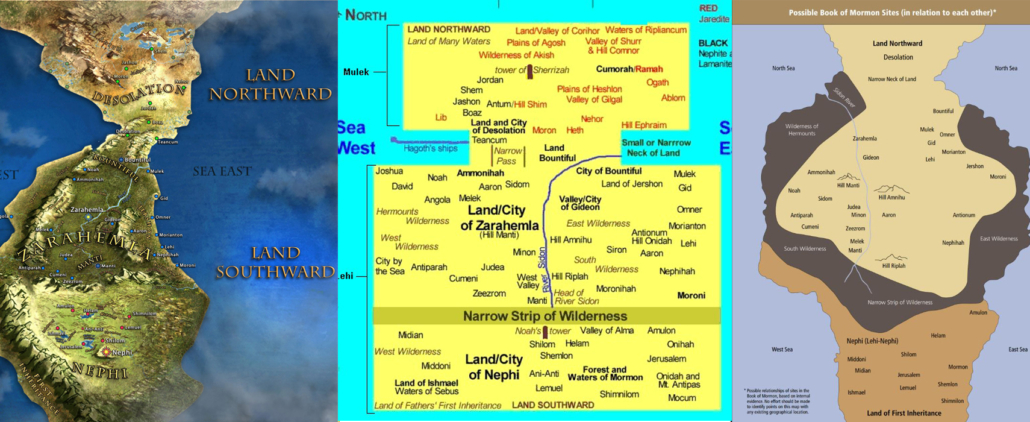
–
Quicklinks/ Jump to Section:
Overview
Apart from the general isthmian nature of Book of Mormon lands suggested in Alma 22 (and explained in detail later), perhaps the most important aspect of any internal model of the Book of Mormon is the relationship between Moroni’s East Coast and Southwestern defensive garrison cities fought over in Alma chapters 50-56. In Alma 50:11 (Alma 50:7–15) we learn that Moroni creates a NEW border between the Nephite and Lamanite lands, and fortifies it with garrisons/cities which run between the Land of Zarahemla and the northern border of the Land of Nephi which Alma 50:8 says runs “in a straight course from the east sea to the west [sea]” (see also Alma 22:27). Read carefully through Alma 50 and pay close attention to the wording and logic concerning these new border fortifications.
10 And he also placed armies on the south, in the borders of their possessions, and caused them to erect fortifications that they might secure… their people… …fortifying the line between the Nephites and the Lamanites, between the land of Zarahemla and the land of Nephi, from the west sea, running by the head of the river Sidon— [to the] foundation of a city, and they called… Moroni; and it was by the east sea. (Alma 50:8–13, esp. verse 11)
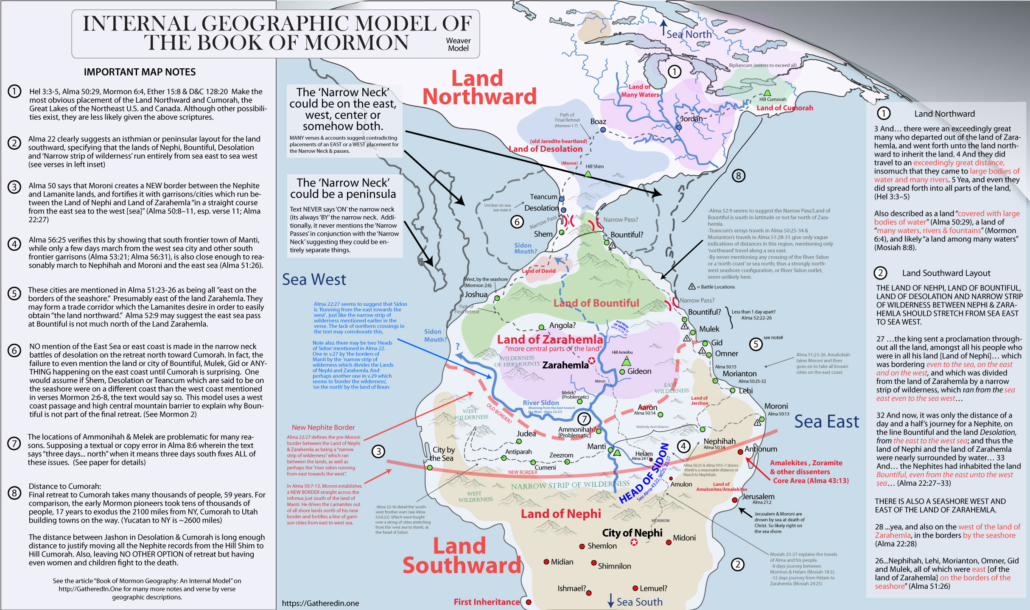
The army march in Alma 52-56 from the West Sea to Manti (particularly Alma 56:25) verifies this by showing that south frontier town of Manti, while only a few days march from the west sea city and other south frontier garrisons (Alma 53:22; Alma 56:31), is also close enough to reasonably march to Nephihah and Moroni and the east sea (Alma 51:26). Alma 59:5–7 also shows Manti is close to Nephihah. Moroni also fortifies the entire east coast from the new southern border all the way to the “Narrow Pass” (Alma 50:34; 52:9) or “Line Bountiful” (Alma 22:32–33) which leads to the land Northward. Basically, making a backward L of defensive cities to guard the Nephite southern frontier and eastern coast. The attention shown by Moroni in fortifying the east coast (and not the west coast), further suggests the east coast posed a greater threat as a travel corridor and mode of entry to Nephite lands than the west coast, almost certainly because Zarahemla and the Nephite center was closer to the east coast than the west coast. As will be seen in a moment, these are vital details that makes almost all existing geographic correlations (whether Heartland models, or Mayanland models) difficult to correlate with the text, because features like the Yucatan Peninsula in Mesoamerican models or shear width of the North American continent and/or configuration of the Great Lakes in Heartland models make the travels of the various armies on these new coast to coast southern defensive borders spoken of in these chapters, incredibly problematic.
Alma 22 lays the most comprehensive geographic groundwork for this border dispute by explaining the general layout of Nephite and Lamanite lands before Moroni’s border realignment. The chapter sets forth the following important geographic relationships.
-The “land of Nephi and the land of Zarahemla were nearly surrounded by water, there being a small neck of land between the land northward [called Mulek or Desolation- Hel 6:10, Alma 22:30] and the land southward [called Lehi or Nephi/Bountiful- (Hel 6:10, Alma 22:29)”. (Alma 22:32)
-Before Captain Moroni’s redefinition of the southern national boundary, the Nephites had become “nearly surrounded by the Lamanites” (Alma 22:29)
-The land of Nephi’s borders stretched “to the sea, on the east and on the west” (Alma 22:27). In other words the Land of Nephi stretched from the East Sea to the West Sea. (see verses 27-30)
-The land of Bountiful, which “the Nephites had inhabited”, was north of Zarahemla and also stretched “even from the east unto the west sea” (Alma 22:33).
-The land of Nephi was “divided from the land of Zarahemla by a narrow strip of wilderness, which [also] ran from the sea east even to the sea west” (Alma 22:27)
-The “head of the river Sidon” or headwaters of the river Sidon were “by” the land of Manti in the Narrow strip of wilderness that separated the lands of Nephi and Zarahemla. (Alma 22:27). Verse 27 also seems to suggest that the river Sidon actually “runs” or flows “from east toward the west” forming a border of sorts between the Nephite and Lamanite lands, just like the narrow strip of wilderness which also is said to have “ran from the sea east even to the sea west” (Alma 22:27).
-Similar to typical English usage, the Book of Mormon seems to differentiate between the seas or oceans (i.e. called either ‘sea’ or ‘many waters’) and lakes (Called simply ‘waters of ’ or ‘bodies of water’). These verses show the word sea = ocean: 1 Ne 18:8, etc, etc, etc. Also ‘Great waters’ = Ocean: Omni 1:16. Contrasted with ‘Waters of’ = lake or river: Mosiah 25:18, Alma 2:34, Alma 18:7, Mormon 1:10. Large bodies of water = large lakes: Alma 50:29, Hel 3:4. One exception is the phrase ‘many waters’, which seems to be used interchangeably with lake or large ocean that inhibits travel ( ‘Many Waters = ocean that divides continents: 1 Nephi 17:5; 1 Nephi 13:10–12. ‘Land of many waters’ = land with lots of large lakes?: Mormon 6:4, Mosiah 8:8).
–
Thus before Captain Moroni, there seems to have been a poorly defined border between the lands of Nephi and Zarahemla through a “narrow strip of wilderness” which ran between the two lands, as well as possibly some part of the “River Sidon”, which seems to repeatedly be used as the strategic battle point to stop Lamanite armies from entering or leaving the land (see Alma 2:15–17, 34–35, Alma 16:6–7, Alma 43:40–41). However, because the Lamanites had moved north of the narrow strip of wilderness along the east and west seashore until they “nearly surrounded” the land of Zarahemla, Captain Moroni decided to drive them out of the east and west coastal areas, until they were south of the new ‘sea to sea’ or ‘coast to coast’ border he created through the land of Manti and cities of Antiparah, Judea, Cumeni, Zeezrom, Nephihah and Moroni. (again, see Alma 50:7–15)
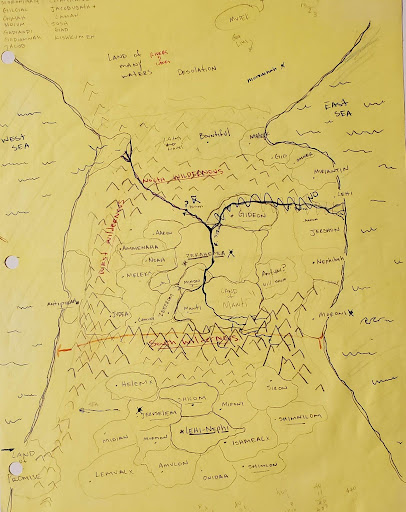
Narrow Neck
Book of Mormon references to the Narrow Neck or Narrow pass are actually a bit confusing and contradictory, leading me to believe there is confusion about it in the mind of the author(s). First off the book never mentions a single occurance happening ON the narrow neck. Instead, each of the two references to it, are BY the narrow neck. It also gives no indication of exactly how wide the narrow neck is and strangely refers to it (or a sea by it) as “the place where the sea divides the land” instead of what we’d expect of a centered isthmus as a place where the land divides the sea. Its also suggested, but never specifically laid out that it contains some type of pass(es) or defensive line that are a day’s journey across in one area (Hel 4:7) and/or a day and a half’s journey in another (Alma 22:32). It is specifically called a “small neck of land” (Alma 22:32, Ether 10:20), or “narrow neck” (Alma 63:5) but then a “narrow pass” or “passage” which led by the sea (Alma 50:34; 52:9, Mormon 2:29; 3:5-6). The distances given, may be only specifically talking about the “the line” which they had fortified (Alma 22:32, Hel 4:7). Since a day and a half’s journey is typically only 15-30 miles, we can assume these distance markers are NOT referring to the whole width of the isthmus (if that’s what it is), since even the narrowest parts of panama are more than 30 miles wide and were referenced as being at least “3 days journey” by Natives in early references (see Balboa, January 20, 1513).
So perhaps it’s safe to assume that if it is an isthmus, it must have contained a rugged mountain range or some impassable feature in addition to the 15-25 mile wide fortified “line(s)” on the coastal plain or travel corridor(s).
Also of important note is that the Book of Mormon (especially the book of Alma) seems to be quite precise when it comes to cardinal directions. Using “northward” instead of just north, and more importantly, directions like “south and west” as well as “west sea, south” and “borders of the land on the south, by the west sea” when referring to the battles for the southwest cities (Alma 52:11–15 & 53:8,22 ). But note it NEVER mentions a north shore or north and west (northwest)/north and east (northeast) shore when talking about the battles for the cities of Bountiful and Mulek or the travels along the east sea or west sea to the land Northward. Chapters dealing with the East sea, strongly suggest the narrow neck is inline with the rest of the East sea. Conversely, the opposite seems true for the final flight of the Nephites to Cumorah (although these battles are glossed over). No mention is made of Bountiful, the River Sidon, the sea east or any east sea city in the final flight before the destruction. (only the WEST sea is mentioned). In fact new ‘lands’ are mentioned we never heard about in the battles on the east sea. The text also refers to various wild animals coming from “the land northward to the wilderness of Hermounts “on the north and west” [of Zarahemla], suggesting some kind of mountainous wilderness corridor on the narrow neck which connects with northwest wilderness of Hermounts. Also when Hagoth launches “into the west sea”, “BY the narrow neck” (not at or on the narrow neck) it seems to suggest there is no northern shore caused by the land narrowing. (ie. the narrow neck is to the west, not north east). Given these details, and asking ourselves why the final flight was along the west sea instead of east, it almost seems like there are two narrow necks… one on the east, and one on the west? At very least the two narrow necks seem somewhat separated.
“by the narrow pass which led by the sea into the land northward, yea, by the sea, on the west and on the east.” (Alma 50:34)
Lastly, it is important to note that the common placement of Teancum on the Sea East is entirely unsupported by the text. ALL references to the sea in the final flight (until arriving in Cumorah) are to the West Sea. And the text suggests that Teancum is quite close to Desolation. (see Final Flight section at the end of this document)
-It was “the distance of a day and a half’s journey for a Nephite, on the line Bountiful and the land Desolation, from the east to the west sea; and thus the land of Nephi and the land of Zarahemla were nearly surrounded by water, there being a small neck of land between the land northward and the land southward”. (Alma 22:32).
-Teancum’s army heads Morianton’s flight northward on the “borders of the land Desolation… by the narrow pass which led by the sea into the land northward, yea, by the sea, on the west and on the east.” (Alma 50:34)
-Moroni orders that Teancum “should fortify the land Bountiful, and secure the narrow pass which led into the land northward, lest the Lamanites should obtain that point and should have power to harass them on every side”. (Alma 52:9)
-Hagoth… went forth and built him an exceedingly large ship, on the borders of the land Bountiful, by the land Desolation, and launched it forth into the west sea, by the narrow neck which led into the land northward. (Alma 63:5)
-Nephite armies of Moroniahah, “fortify against the Lamanites, from the west sea, even unto the east; it being a day’s journey for a Nephite, on the line which they had fortified and stationed their armies to defend their north country.” (Hel 4:6–7)
-A peace treaty is made wherein the “Lamanites did give unto us the land northward, yea, even to the narrow passage which led into the land southward. And we did give unto the Lamanites all the land southward.” (Mormon 2:29)
-The Nephites gather to Desolation, “to a city which was in the borders, by the narrow pass which led into the land southward… that we might stop the armies of the Lamanites, that they might not get possession of any of our [northern] lands” (Mormon 3:5–6)
-Lib “built a great city by the narrow neck of land, by the place where the sea divides the land. And they did preserve the land southward for a wilderness, to get game.” (Ether 10:20–21)
| Reference | Exact Wording | Sea west mentioned? | Sea east mentioned? | Days jour-ney | Directional indicators |
| Alma 22:32–33 | “small neck of land” or “the line Bountiful” | yes | possibly | 1.5 | from the east to the west sea |
| Alma 50:34 | “the narrow pass” | yes | no. implied? | by the sea, on the west and on the east | |
| Alma 52:9 | “the narrow pass” | no | |||
| Alma 63:5 | “the narrow neck” | yes | no | the west sea | |
| Hel 4:6–7 | “the line” | yes | no. implied? | 1 | from the west sea, even unto the east |
| Mormon 2:29 | “the narrow passage” | no | |||
| Mormon 3:5–6 | “the narrow pass” | no | |||
| Ether 10:20–21 | “narrow neck of land” | no. implied? | no. implied? | place where the sea divides the land |
.
Ammonihah, Land of
Ammonihah and Melek are two of the most problematic cities in Book of Mormon Geography. This because so many features mentioned in relation to this cities seem to contradict each other. I believe these contradictions could be caused by a copy/translation error made by Mormon or Joseph Smith where the city is said to be NORTH of Melek, when in fact perhaps its SOUTH of Melek. See discussion for details.
-It was 3 days travel on the north [possibly south?] of the land/city of Melek (which was west of Sidon by a/the west? wilderness) , (Alma 8:6).
-It was on the border of the greater land of Zarahemla (Alma 25:2). Likely northern border if it really was north of Melek, but southern border if in reality it was south of Melek.
-It was near, and probably west? of, the city/land of Sidom (Alma 15:1). Likely less than a days Journey (15 miles)
-It was near the city of Noah (Alma 16:2–3). The Lamanite armies destroy “some around the borders of Noah” after sacking Ammonihah. They also go straight to Noah after attempting to sack Ammonihah after its rebuilt (Alma 49:12–14). Noah is mentioned nowhere else in the text.
-It was near the city of Aaron. At least Alma “took a journey toward the city called Aaron” after being cast out of Ammonihah (Alma 8:13). Which seems likely the same as the East coast city of Aaron between Moroni & Nephihah (Alma 50:14), perhaps by Jershon and named after Aaron the Missionary of Alma 31.
-The or a wilderness abutted Ammonihah on the west (Alma 8:5).
-There is a pass of some sort between it and Zarahemla which requires ‘coming over’. (Alma 15:18)
-There were 2 routes into the city (Alma 8:16).
-It was fortified with Moroni’s ditch and mound system (Alma 49:4). But beforehand considered “the weakest part of the land”, thus obviously a frontier town. (Alma 49:15)
discussion: Ammonihah is twice attacked by Lamanite armies on account of its convenience (before or after the border was moved?). Alma 49:3 calls it “easy prey” and Alma 49:15 calls it “the weakest part of the Land”. Alma 25:2 says its “on the borders of Zarahemla”. So the question is which border? The fact that its the first place of convenient attack to the Lamanites angry at the conversion of the Lamanites in Alma 25:1–2 would suggest it is on the SOUTH border close to the city of Nephi. This is substantiated by the mention of Alma “took his journey toward… Aaron” after being cast out of Ammonihah (Alma 8:13), since we know Aaron is near Nephihah and Moroni on the southeast coast (Alma 50:7–15, esp v.14). So given a careful reading of Alma 50, how can Ammonihah be put on the northwest coast? Another likely evidence that the city is SOUTH of Melek instead of north is found in Alma 8:16–18 where we learn that when Alma returns to the city after being instructed by the angel to return he sneaks in the backdoor of the city “which is on the south of the city”. If the city was North of Zarahemla, why would the backway into the city be on the south? This verse suggests that the city is actually south of Zarahemla and Melek along with Noah, Aaron and Nephihah. In fact just the names of this cities should suggest that they are close to the Land of Nephi, likely being named after Aaron the son of Mosiah, and possibly Noah the wicked king. Also, the leaders of Ammonihah are some of the first to fully convert to the Order of Nehor (Alma 15:15) and Nehor seems to have lived/preached mostly around the areas of the Amalekites and Amulonites (Alma 24:28) whose home was close to Helem eight days from the city of Nephi (Mosiah 23). Also, since the people of Jershon flee Jershon and go to Melek to avoid the Zoramite attack… Ammonihah isn’t likely that far from Jershon! (since Ammonihah is 3 days journey from Melek, and having the people of Ammon flee 200 miles from their new home Jershon to another new home that is also on the edge of Nephite lands doesn’t make much sense, unless they were insisting on moving closer to their sons guarding the border so they could get them regular provisions!).
Because of the above difficulties, many have speculated there are two Melek’s and two Aaron’s because of the confusion. (including the BOM topical guide). But I believe all these confusions are fixed by assuming that the “3 days north of Melek” is an error, and it is actually 3 days south (could be wrong on this).
Note that the retreating army of Lamanites after sacking Ammonihah and Noah in Alma 16 is perhaps the best indication of where this city is. It suggests Ammonihah is a first city in the Nephite lands when an army “come in upon the wilderness side, into the borders of the land [of Zarahemla]” (Alma 16:2). Not only does Alma 16 say NOTHING about the west sea in this chapter — which seems to go against the common habit/mistake of putting Ammonihah somewhere near the west sea on the north (that’s a big assumption though). But after destroying Ammonihah, as they head back to the land of Nephi with their prisoners, Alma tells the Nephite generals to head them off near “the river Sidon in the south wilderness, away up beyond the borders of the land of Manti” (Alma 16:6). Looking at internal maps or most Mesoamerican models we see how little sense this path of retreat makes given what we know of Manti (see Manti and Sidon, Head of). Why would they go back through the central part of the land to hightail it home, after purposefully sneaking into the “weakest part of the land?” (Alma 49:15) If Ammonihah is near the coast then surely they would take the coastal route back to the Land of Nephi, and not make a strange jaunt inland to cross the headwaters of Sidon only to head back toward the coast and arrive in the Land of Nephi! (Note a lot of this logic assumes the land of Nephi is just the Oaxaca Valley. But it could have included the southeastern Mixtec lands. Many of the Lamanite attacks might have come from Monte Negro, which is why the Tehuacan Valley is rarely used.)
.
Antionum, Land of
-Antionum is “the land of the Zoramites” (Alma 31, Alma 43:5), yet it seems to have been in Nephite territory or the border of Nephite territory during Moroni’s time.
-It is “east of the land of Zarahemla, which lay nearly bordering upon the seashore, which was south of the land of Jershon, which also bordered upon the wilderness south” (Alma 31:3)
-After their mission to the Zoramites, Alma and Amulek go rest at Jershon (so its close). Alma 35:2
-Bordering the land of Jershon & the “wilderness” (Alma 43:15, see Alma 43:5,15,22)
discussion: Alma 43, is important as it establishes that Antionum and Jershon are very close to each other, and likely closest to Manti and the “head of Sidon”, more than Zarahemla or other Nephite cities. It also establishes Antionum as the likely southernmost city of the east border/coast cities, since it was the first place the Zoramites reached as they came up the coast for battle. But both it and Jershon are NEARLY bordering the shore, but not ON the shore, and yet BORDERING the south wilderness. So they seem to be where the coastal plain meets the mountains/wilderness and BORDERING the south wilderness. Its initially In Nephite territory, but Zoramite mission is because they fear they might join the Lamanites and thus endanger Nephite lands (Alma 31:4)
Geographic model notes: note this means it has to be SOUTH of Zarahemla & thus Catonia (which Jershon could be), and perhaps as far south as Tehuacan or even La Coyotera (thats probably too far). Probably on the upper or lower border of the coastal mountains. I get the feeling that the entire coastal plain is refered to as the “borders of the seashore”, so the fact that it is only “nearly” bordering the seashore, it is NOT down on the coastal plain.
.
Aaron, City of
Alma 50:14. Nephihah is built by Moroni, between the city of Moroni and Aaron. So they are likely all defensive cities. Moroni and Nephihah are built specifically to hedge out the Lamanites.
discussion: The topical guide and many others speculate that there are two Aaron’s because Alma heads “towards” Aaron after giving up on preaching to Ammonihah (Alma 8:13), but is “called back” by an angel. YET, Alma 50:14, says they built Nephihah (a defensive city) between Moroni and Aaron (so east coast cities).
However I think there might just be one, as it doesn’t actually say Nephihah is on the coast. So maybe Aaron isn’t either. Maybe Moroni is on the coast, and Nephihah and Aaron stretch inland and form a southern border of Nephite lands? Seems likely these are some of the cities mentioned in Alma 50:10, where he says “he placed armies in the south, in the borders”. This would actually help make more sense of Alma 56:25, where it says the Lamanite army fighting manti “durst not march down against Zarahemla, or cross the head of Sidon over to the city of Nephihah.” It also makes sense, because most of the cities built by Moroni were built to fortify the southern border between the lands of Nephi and Zarahemla.
.
Melek, Land of
-Alma 8:3–4 says Melek is “west of the river Sidon, on the west by the borders of the wilderness”.
-Alma 8:6 says it’s three days Journey south of Ammonihah. (which I believe could be an error. See Ammonihah)
-Alma 31:6 agrees it’s close to Ammonihah (since Amulek and Zeezrom are there). Either way, this chapter gives more support to the idea that Melek is close to Jershon and the Zoramites. (by the east sea)
-West of the Sidon River by the borders (on the edge of) of the wilderness (Alma 8:3).
-The land was large enough to contain the displaced Ammonites from Jerson (Alma 35:13). Probably very good agriculturally, and secure in order for the Ammonites to be moved there once their land was deemed an unsafe frontier.
-It was near the city of Noah (Alma 16:2–3). The Lamanite armies destroy “some around the borders of Noah” after sacking Ammonihah. They also go straight to Noah after attempting to sack Ammonihah after its rebuilt (Alma 49:12–14). Noah is mentioned nowhere else in the text.
-It was near the city of Aaron. At least Alma “took a journey toward the city called Aaron” after being cast out of Ammonihah (Alma 8:13). Which seems likely the same as the East coast city of Aaron between Moroni & Nephihah (Alma 50:14), perhaps by Jershon and named after Aaron the Missionary of Alma 31.
-It was where Alma seemed to be headed toward when he left the land never to return. (likely headed to the Land Northward via the west coast).
–
discussion: This is one of the hardest of ANY cities in the book of Mormon to place. (making it fit with Ammonihah, Jershon and Noah) Many have speculated there are two Melek’s because it makes little sense for the people of Ammon to go from the East coast to somewhere near the “west wilderness”, and “west of Sidon”. The location of this city is tied to the location of Ammonihah. Alma 8:3 may lead to speculate the Melek was far in the west by the west sea and west wilderness. However, since the Ammonites flee there, it must still be reasonably close to the East Sea where Jershon was. Its hard to say exactly what encompasses the “west wilderness” of Alma 8:3 (Alma 27:22 makes it clear Jershon is “on the east by the sea”.) It could be across the river from Gideon (which is on the east of Sidon),
Geographic model notes: Perhaps “west of sidon” doesn’t mean by the West Sea, but west of a Sidon tributary, like where Puebla is or even Acatlan. (see Jershon). Of course it’s possible that anything west of Zarahemla/Cholula/Popocatepetl could be considered the “west wilderness”. I’m guessing somewhere like Chalcatzingo/Ocuituco/Chalco or Cuernavaca or south to Cuetlajuchitlán or even Teopantecuanitlan (but thats a LONG way for a people to fee, although they’d already come from Nephi and may have wanted to move closer to relatives in Nephi AND more importantly closer to thier sons, so they could bring them provisions as they guarded the border!). Or it could be farther west like Chalcatzingo (but why would the Ammonites flee there if its that far?). How do you get a configuration that is west of the river Sidon, but close to the East sea and Jershon? I’ll bet its good agricultural land, but quite possibly closer to the “southwest” cities that their 2000 sons were defending. Lower Cuernavaca, lower Chalcantango or even into the Mixtec lands (look up Mixtecapa). Likely very guarded by mountains or some similar terrain.
.
Mulek, Land of – (see Bountiful)
-on east borders by seashore, possessed by Amalickiah: Alma 51:25–26 .
-Moroni retakes Mulek: Alma 52:16–26 . ( Alma 53:2, 6 )
-heavily fortified. Not too far from city of Bountiful. (Alma 52:17) Not too far from the seashore (Alms 52:22). Teancum retreat north along the seashore away from the city (v. 23). Likely less than a few hours south-east of Bountiful. (see discussion)
-there are plains between Mulek and Bountiful that could serve as a battleground. (Alms 52:20)
-likely named after Mulek the son of Zedekiah who first landed in the “Land North”. (Helaman 6:10) Perhaps close to their landing? Or perhaps just so far in the north that it is named after the north region of “Mulek”.
discussion: The location of this city is tied to city of Bountiful per Alma 52. Teanucm flees Mulek (east?) to the seashore (v. 20), then flees northward (v. 23) toward the city of Bountiful (v. 27,39)
.
Noah, City of – (see Bountiful)
–A city close to Ammonihah. All we know of it, is when the Lamanites attack Ammonihah the first time, they attack Noah also, and take many prisoners (Alma 16:2–3). And some geography is described when they head off the Lamanites on their way home with the prisoners (16:5-8). Then after Ammonihah is rebuilt and fortified, the lamanites come against Noah again, but this time it’s a fortress (Alma 49:12–15). After suffering many casualties, they head back to the land of Nephi. In Alma 49:15, it’s called “the weakest part of the land”. Thats another reason to believe its not in the mountains or way out of the way, but in a major thoroughfare.
.
Bountiful, City of – (see Mulek)
-Moroni & Teancum force Lamanite prisoners to dig a ditch and dirt brim about the city. It becomes a stronghold “ever after”. (Alma 53:2–5)
-it is near the city of Mulek, (eastward?), and presumably near the east? seashore. (Alms 52:20)
-it is near the pass which leads to the land northward. Likely the most northern of the string of east coast cities (Alma 52:11–15?)
discussion: Alma 52:11 talks about how Moroni is over by the west sea fighting, and sends an epistle to Teancum who is by the east sea cities of Mulek and Bountiful, and tells him to” secure the pass which led into the land northward” (v. 9). This makes no sense unless he’s talking about an EAST SEA PASS. Moroni leaves the west coast and marches to Bountiful and the EAST coast (v. 15).
Geographic model notes: So Bountiful could only be somewhere like Tamtoc or ruins in Tampico!
.
South & West Cities
Zeezroom, Cumeni, Antiparah & Judea. Described as being presumably on the borders of the land on the south by the west sea (Alma 53:8,22)
-They appear to stretch in a line from Manti in the order of Manti, Zeezrom, Cumeni, Antiparah, Judea? (Alma 56:14). They are retaken by Helaman’s 2000 warriors in reverse order.
-The cities of were apparently on the south and west border of the Nephite lands and were the first cities captured by the Lamanite invaders (Alma 56:14). Alma 52:11–12 describes Ammaron’s intent to assault the “borders by the west sea”.
-Manti is consistently mentioned in conjunction with the river Sidon (especially it’s ‘head’). But the river Sidon is never mentioned in the war for these cities… so it’s likely near Manti but not between these cities.
-Antiparah was between the city of Judea and an unnamed Nephite city near the seashore (Alma 56:30). We can presume this is the west sea, although it’s strange that Nephihah (which Alma 51:26 says is by the East Sea) is mentioned in conjunction with these cities (Alma 56:25).
-The fact that Zarahemla and Nephihah (which Alma 51:26 says is by the East Sea) is mentioned in conjunction of these cities is another great evidence that these South & West Cities are stretching in a line from the West Sea toward the East Sea. (with the head of Sidon being beyond Manti, yet between these and Nephihah — Alma 56:25)
-The Nephite armies could flee two days northward from Antiparah into the wilderness without reaching the shore or Zarahemla (Alma 56:33–42).
-Cumeni seems to be just west of Manti (Alma 57:22). Cumeni doesn’t appear to have been a fortified city (Alma 57:16–20).
-In battle for Cumeni, defeated Lamanites were driven back to nearby city of Manti (Alma 57:22).
Some or all of these cities were fortified (Alma 56:20–21).
-Zeezrom is likely right next to Manti, because it’s never mentioned again after verse 22. After Cumeni the war goes straight to Manti.
-going from these cities to Nephihah would require crossing “the head of Sidon”. Nephihah and Zarahamla were the closest options of Lamanite attack from these cities (Alma 56:25). That might be a good evidence that the ‘head’ of Sidon is it’s headwaters which are close to Nephihah and the east sea.
-there are “other cities which were on the northward”, which are not mentioned by name (Alma 56:22). This again suggests that these cities are the southern (or possibly southwestern? – but I think not) frontier.
discussion: The cities defended by Helaman’s 2000 stripling warriors in Alma 56-57 are said to be “southern cities” by the west sea, which Moroni must have been guarding before he went to help Teancum with the Eastern front- Alma 52:11–52. (Moroni left Helaman & Antipus in charge when he left.) Additionally, prisoners from this group are sent down to Zarahemla (suggesting it’s close by & lower). Helaman says in Alma 56:14 the Lamanites had taken Manti, Zeezrom, Cumeni and Antiparah (in that order) when he gets to Judea. The cities are then retaken in the reverse order (with no mention of Zeezrom).
Military maneuvers begin in Judea (Alma 56:9). Helaman then marches past (but within sight of spies) Antiparah as if to go “to a city beyond by the seashore” as a decoy (possibly northward. see v. 36). When the Lamanites take the bait they flee a full day “northward, even to a considerable distance” (v. 36-37). Probably heading somewhat toward the sea still. After the battle prisoners are sent to Zarahamla, not back to Judea, so their march must have put them closer to Zarahamla. After heading back to Judea, the Lamanites abandon Antiparah, so the Nephites march and siege Cumeni— which is surrendered. The next battle is for Manti.
Heleman’s army then decoys the Lamanites out of Manti and then flees “much in the wilderness” toward Zarahemla, so it can’t be that far from Zarahamla (58:23-28). I suspect that Judea might be by the shore near Acapulco (La Sabana), and Manti near Tehuacan, with the other cities strung between. So this is the southwest frontier, and Teancum/Mororni’s battles were the eastern frontier.
Geographic model notes: Perhaps Oxtotitlan Cave and Juxtlahuaca Cave were painted during this Lamanite assault? (dates are typical ascribed earlier.) Possibly, La Sabana, Teopantecuanitlan by the river Sidon, Cuetlajuchitlán and Chalcatzingo or Xochicalco near Cuernavaca (Manti being Cholula near Puebla or Chalcatzingo or Tenongo).
.
East Sea Cities
At least four cities (and likely nine) border the East Sea, Moroni, Aaron, Nephihah and Jershon. (Lehi, Morianton, Omner, Gid, Mulek seem near the sea but could be inland a ways)
MORONI, AARON
-It was located on the shore of the east sea and was near the south wilderness of the Lamanites (Alma 50:13).
-The land of Moroni bordered the land of Aaron, and the city of Nephihah was built in between (Alma 50:14).
-Lehi was a nearby city to the north (Alma 50:15; 51:24).
-Moroni was surrounded by a wall (probably the trench-mound-palisade fortifications of Moroni) (Alma 62:36).
-Submerged in the sea. Perhaps still underwater. (3 Ne. 8:9).
NEPHIHAH, LEHI
-It was located between Moroni and Aaron (Alma 50:14–15).
-It was in the borders by the east sea, but apparently not right on the seashore (Alma 51:25–26).
-There was a plain near the city (Alma 62:18).
-The city had walls and an entrance (Alma 61:20–22).
-It was south of the city of Lehi (Alma 51:25).
MORIANTON, OMNER, GID & MULEK,
-They were on the east on the borders by the seashore (Alma 51:26).
-They were built for defense and were probably about a days journey apart (Alma 50:9–11).
-Mulek was less than a day’s journey from the city of Bountiful (Alma Ch. 52).
-Lehi and Morianton were probably built in close proximity to each other-because they have a boundary dispute (Alma 50:25–36)
-These cities were all fortified with a ditch, mound and wooden palisade (Alma 51:27, 55:25-26).
-Heleman’s sons take a missionary journey from Bountiful, to Gid, to Mulek to Zarahemla to the Lamanites in the land Southward (Helaman 5:15–16). Note the direction error in v 16.
discussion: when Amalickiah comes to battle the Nephites in Alma 51, he first takes the city of Moroni and “all of their fortifications”, and then goes on to “take Nephihah, Lehi, Morianton, Omner, Gid and Mulek, all of which were east on the borders of the seashore” (Alma 51:26), suggesting that those cities were arranged in that order from south to north along the east sea. They then “march forth… that they might take possession of the land Bountiful and also the land northward” (Alma 51:30). After Teancum kills Amalickiah on the way to Bountiful, they retreat back to Mulek. At that point Moroni sends a letter telling Teancum to secure the narrow pass, because he “cannot come” because he is occupied with a Lamanite attack “on the borders of the west sea”. This suggests the western cities are a long way from these eastern cities and the narrow pass.
.
Gideon, Land of
-It was situated east of the River Sidon and about a days journey from Zarahemla, (Alma 6:7).
-A trail led southward from Gideon to Manti, and also to the land of Nephi (Alma 17:1)
-The Land of Gideon was at a higher elevation than the City of Zarahemla (Alma 62:6–7).
-It was near the hill Amnihu, and “in the course of” or on the way to the land of Nephi (Alma 2:15–20).
-It was located between the city of Zarahemla and the city of Minon (Alma 2:24)..
-The ‘Valley Gideon’ is likely east of the River Sidon (alma 2:35)? At any rate you must cross sidon to get from the valley of Gideon to the city of Zarahemla
Geographic model notes: If Zarahemla is Cholula, East Publa is a fantastic match for Gideon with La Malinche matching the Hill Riplah. (but does Amla 2 fit with that well?)
.
Jershon, Land of
-It was “east by the sea”, south of the land of Bountiful (joining borders with Bountiful), and bordering on the south wilderness (Alma 27:22). The Lamanites had to be driven out of it, and it became a buffer between Bountiful and the Lamanite Lands.
-It was east of the city of Zarahema (Alma 27:22).
-It was lower in elevation than the south wilderness (Alma 27:26).
-It was north of the land of Antionum, or land of the Zoramites (Alma 31:3).
-It was likely near the eastern coastal cities of Mulek, Gid, Omner, Morianton, Lehi, Nephihah, and Moroni. (ref?)
-It’s just north of the Zoramites of Antionum, “which was east of the land of Zarahemla, which lay nearly bordering upon the seashore, which was south of the land of Jershon, which also bordered upon the wilderness south, which wilderness was full of the Lamanites” (Alma 31:3).
-It’s not far from Melek? since the people of Ammon temporarily flee to Melek when the Zoramites prepare to attack (Alma 35:13–14). In most models this is problematic, because Alma 8:3–4 says Melek is “west of the river Sidon, on the west by the borders of the wilderness.” Is moving the people of Jershon all the way across the continent (200 miles?) really rational? Perhaps this doesn’t mean by the west sea, but west of a Sidon tributary?
-Alma 8:6 says Melek is three days Journey south of Ammonihah. Alma 31:6 agrees it’s close to Ammonihah (since Amulek and Zeezrom are there). Either way, this chapter gives more support to the idea that Melek is close to Jershon and the Zoramites.
.
Jerusalem, City of
-It was drown at the death of Christ (3 Ne 9:7), and mentioned with many other drown cities, so likely a coastal city.
-It was “joining the borders of Mormon”,(and thus Helam?) and where Aaron went first on his mission to the Lamanites (Alma 21:1)
-The Amalekites and Amulonites built it (Alma 21:2)
-It was near to Ani-Anti and Middoni (Alma 21:11–12)
-Amulon, Helam & Jerusalem all seem to be in proximity (Alma 24:1)
Find verse that puts Amulonites and Amalekites with Zoramites suggesting their regions are in close proximity on the east coast.
.
Helam, Alma, Amulon (cities in Alma’s flight to Zarahemla)
-Helam is 8 days journey into the wilderness from the city of Nephi (Mosiah 23:3).
-Helam is 12 (or 13) days journey from the city of Zarahemla (Thus likely about 2/5’s between Nephi & Zarahemla. Mosiah 24:23–25).
-Helam was in a “beautiful and pleasant land… of pure water” in an area suitable for agriculture (Mosiah 23:4–5).
-The Valley of Alma was one days journey (probably northward) from Helam (Mosiah 24:20).
-Amulon was founded by the Amulonites and near Alma’s city of Helam. (Mosiah 23:30–35)
-All these locations were in the south wilderness somewhere between Nephi and Zarahemla. (8 days from Nephi & 12 days from Zarahemla)
-The Amalekites & Amulonites of Jerusalem seem to be in proximity to the Zoramites of Antionum (Alma 43:5–6)
-Both the Amalekites & Amulonites of Jerusalem & Zoramites of Antionum are in proximity to Jerson which is by the east sea (Alma 43:4, Alma 35:2–11).
-Amulonites who battle with the Nephites flee into the EAST wilderness (Alma 25:5).
Discussion: Evidence is split between these lands being toward the west or east coast. On one hand Alma 21:1–14 has Aaron and his brother preaching in Jerusalem the land of the Amalakites & Amulonites (v. 2), where they are rejected and go to the nearby cities of Ani-Anti & Middoni where they are cast into prison (v, 13) and kept there until Lamoni & Ammon deliver them (v. 14). Which might suggest a west coast location since Ishmeal is synonymous with the ‘Land of first Inheritance (Alma 21:18), which is on the seashore west of the Land of Nephi (Alma 22:28). However, 2 Nephi 5:7 has the city/land of Nephi being “many days” from the land of first inheritance so we can’t be sure Ammon & Lamoni didn’t cross the land were it a narrow location. Especially since on the flip side Alma 43:5–6 seems to have the Amalekites & Amulonites of Jerusalem in proximity to the Zoramites of Antionum which we know are by the east sea (Alma 35:2–11). Furthermore Alma 25:5 has Amulonites fleeing home from Nephite battles going into the EAST wilderness. And again, at the Destructions of Christ the Amalekite city of Jerusalem has “waters caused to come up in the stead thereof” (3 Nephi 9:7) just like the southeast coast (Alma 50:13) city of Moroni which is “sunk into the depths of the sea, and the inhabitants thereof were drowned” (3 Nephi 8:9). 4 Nephi 1:9 seems to suggest that many of these sunk cities were not just destroyed by a tsunami, but that a sizable region of coast line sluffed off or sank into the sea. (Although on some of these cities a lake could be involved instead of the sea). Furthermore Alma 43 seems to suggest that the land of the Zoramites and Amalikes are in proximity, and that the Amakite Zerahemnah starts his war by recruiting Zoramites then attempting war with Jerson (again on the east coast), and then going to Manti (which must be less than a few days journey away).
The Sorenson model puts the lands of the Amulonites and Amalakites (which we know were near Helam & Alma) along the west or pacific coast of Northern Guatemala. But note this is a very poor placement for several locations. Firstly, his location is near Izapa and many archaeological sites which have unbroken archaeological records dating from early formative Olmec times all the way to the time of Christ. Sites like La Blanca, La Victoria, Takalik Abaj and El Mesak. Placing Alma and the land of Helam anywhere near Lamanite or Lehite population centers does not make sense. More importantly this region is lies in the flat western coastal plane and ancient travel corridor where really only a fool wouldn’t be able to find their way to the coast and then up the known river undoubtedly linking the city of Nephi to the coast, yet Mosiah 23:36–37 shows that the Journey from Helam to Nephi was difficult to find causing the Lamanite army to become lost, strongly suggesting that Helam was in an area away from any typical travel corridors.
These lands are near the people of Ammon who get converted so it makes no sense that they are given Jershon on the east coast if they are from the east coast! (explain more and reference this…)
.
Ishmael, Land of
-Is the home of Lamoni. (Alma 17:21, Alma 21:18)
-Is “the land of their inheritance” (Alma 21:18), which is likely synonymous with the ‘land of first inheritance’.
-Place of their father’s first inheritance is ‘west in the land of Nephi… bordering along by the seashore’ (Alma 22:28)
Since Alma 17:21 specifies Lamoni ‘was a descendant of Ishmael’ we assume that Ishmael did not follow Nephi or Laman into the wilderness but stayed in the land of first inheritance, since according to Alma 21:18 which calls it the land of first inheritance, and also places it in proximity to the land of Middoni (although a distance is not given and could be substantial the context suggests it is within a few days journey of Nephi and Middoni which is in turn somewhat close to Helam and Amulon, etc.
.
Sidon, River (28 uses)
A seemingly major or geographically significant river. The only named river in the Book of Mormon. It has east and west banks… but also may run/flow “from east to west” just like the ‘narrow strip of wilderness’ between the land of Nephi and Zarahemla (Alma 22:27). The majority of references to the river, refer to coming and going armies or people between the land of Nephi and land Zarahemla, suggesting it forms an important geographic boundary of some sort. (further supporting the above east/west interpretation of Alma 22:27). A north/south direction of the entire river or perhaps just some of its arms is inferred by it’s running by the land of Zarahemla (Alma 2:15) while its head is said to be near Manti (Alma 16:6–7; 22:27).
-hill Amnihu is on east of Sidon: Alma 2:15 .
-it “ran BY the land of Zarahemla”: Alma 2:15 .
-Lamanites camp on west of Sidon: Alma 2:34 .
-many are baptized in waters of Sidon: Alma 4:4 .
-wilderness at Sidon: Alma 22:29 .
-One must go round about the river’s head when traveling from Jershon/Antionum to Manti (Alma 43:22).
-One must presumably cross from the west to east side of it traveling from Zarahemla to Gideon (Alma 6:7). The city and valley of Gideon are on the east side of the river. (in the region of Zarahemla and Gideon it flows north-south.
-An army must cross it (presumably on foot) going from Gideon to Zarahemla. (Alma 2:27,34). It has banks that can serve as battlegrounds.
-It was large enough to carry the bodies of the dead Lamanites out to the sea. (Alma 3:3)
-But it was small enough for an army to easily cross without boats/etc. (Alma 43:35–41, Alma 16:6–7)
-Perhaps “bordering on the wilderness” and going “from east to the west”. Alma 22:29 If the “wilderness” mentioned in Alma 22:29 is the same as the “narrow strip of wilderness” in verse 27 (which seems likely), then the head of Sidon is likely IN the narrow strip of wilderness that divides the Nephite and Lamanite lands.
-It apparently must be crossed as one goes from the Land of Nephi to the Land of Zarahemla (further supporting it being some kind of east-west running barrier like the south wilderness) Alma 16:6, Alma 2, Alma 43 .
-It was west of the hill Amnihu. Suggesting it runs north/south at that point. (Alma 2:15)
-It was west of the Valley of Gideon. (Alma 2:26; 6:7)
-The City of Melek was to the west of the Sidon–again suggesting a north-south flow in this region. (Alma 8:3)
-The City of Manti was at the headwaters of the Sidon near the south wilderness. (Alma 16:6–7; 22:27)
-The head of the River Sidon extended into the south wilderness, and created an obvious crossing point on the way to Nephi. (Alma 43:22).
-Runs between the Valley of Gideon (which is west of Zarahemla), then through “the land of Zarahemla”, but likely not through the city. (Alma 2:15, since the bodies of Alma 2:34 would then float through the city).)
-Likely either too large to safely cross, or down in a canyon or deep valley in most places as the crossing points seem limited & predictable (Alma 16:6, Alma 2)
discussion: The biblical name of this river is INCREDIBLY relevant. The city Sidon in Lebanon, was the boundary between the Jews and the Canaanites. Gen 10:15 gives Sidon as the firstborn of Canaan. Gen 10:19 shows that a city (river?) named Sidon was the northern “border of the Canaanites” extending down to Gaza, Gerar and Gomorrah. In this sense, it would appear that the Nephites also used the River (which they likely named Sidon after the ‘gentile’ city forming the border of Israel) as the border between the Nephite (Israelite) nation and the Lamanites (Canaanites).
Alma 22:27 ambiguously gives several geographic descriptions ending with the words “through the borders of Manti, by the head of the river Sidon, running from the east towards the west”. One way to read this is that it’s saying that the river Sidon “runs from east to west”. This verbiage isn’t unique as Alma 2:15, also uses the words “running” to show directionality of the river by the land of Zarahemla.
Although unlikely, it is also possible this verse is for some reason simply redundantly repeating the clause earlier in the verse where the “narrow strip of wilderness… runs from sea east even to sea west”. The idea that a region might also “run” like a river is also used in Alma 50:8 where the land of Nephi is said to “run in a straight course from the east sea to the west”. I actually believe it is both, as the author is trying to explain that Sidon, just like the lands of Bountiful and Nephi and the south wilderness “runs” from east to west nearly all the way across the land. (that’s why its repeated twice in v.27). This idea is further supported by Alma 16:6, where Alma prophecies that the Lamanites as they flee home will “cross the river Sidon in the south wilderness, away up beyond the borders of the land Manti”. As if Sidon was some kind of border which Zoram ‘expected’ the Lamanites would have to cross (and there were only so many expected places to easily cross it, so as to know where Alma was talking about). This also accords with other places in the text where the river Sidon appears to be the best place to meet Lamanite armies as they head toward the Land of Zarahemla (Alma 2, Alma 43). A generally east to west configuration helps explain why no mention of crossing Sidon’s mouth/delta is ever mentioned in conjunction with the East Coast defensive cities, OR with the final retreat of the Nephites to Desolation along the West Coast. If Sidon flowed north wouldn’t Moroni mention that they crossed it!
HOWEVER, we must also note that the only ‘banks’ ever mentioned in relation to the river are east-west ones (Alma 16:6, Alma 43:27,53), suggesting that at least in the places where it is most often crossed, it flows north-south. Also… the head (headwaters we assume) of Sidon are consistently mentioned as being in or near the Land of Manti, which we also know is south of Zarahemla (between the Land of Zarahemla and the Land of Nephi). And since we also know the river flows through the land and even near the city of Zarahemla (Alma 2:15) and city of Gideon (Alma 2:26; 6:7) and other central Nephite regions, this reinforces that at least part of the river flows from south to north.
.
Sidon, Head of (5 uses)
“Head” is defined in websters 1828 dictionary as “n. To originate; to spring; to have its source, as a river.” Also “n. The part most remote [or opposite] from the mouth or opening into the sea; as the head of a bay, gulf or creek.” Also “n. The principal source of a stream; as the head of the Nile.” the head of a river is NOT the mouth of a river. Attempting to make it such is a wild stretch.
Additionally, attempting to make the “head of Sidon”, mean the mouth or delta of the river run into possible problems in explaining a setup where the Lamanite armies leave coastal Jerson/Antionum and go “round about in the wilderness…by the head of Sidon” to get to Manti (Alma 43:22–27) which is known to be “up” and on the way to Nephi (which is also always “up”).
-Ambiguous, run-on sentences here. But Sidon likely “running from the east toward the west” just like the “narrow strip of wilderness which ran from sea east even to sea west” and apparently dividing the Land of Nephi and Zarahemla along with the narrow strip of wilderness. Alma 22:27. See discussion on Sidon, River..
-Perhaps a second(?) “head of the river Sidon” mentioned in Alma 27:29 which is “on the north” or “northern parts of the land bordering on the wilderness” near bountiful.
-Exists as an obstacle between Manti/Zeezrom and Nephihah, when going “round about in the wilderness”. Alma 56:25
-Exists as an obstacle between Jershon and Manti, when going “round about in the wilderness”. Alma 43:22
-It’s in the south-east, being between Lamanite armies (of the south & west cities) and the city of Nephihah (on the east sea). Alma 56:25
-Perhaps “bordering on the wilderness” and going “from east to the west”. Alma 22:29 If the “wilderness” mentioned in Alma 22:29 is the same as the “narrow strip of wilderness” in verse 27 (which seems likely), then the head of Sidon is likely IN the narrow strip of wilderness that divides the Nephite and Lamanite lands.
-“From the west sea, running by the head of Sidon” Alma 50:8,11 See discussion.
-Alma 50:11 could possibly suggest the ‘head of Sidon’ is near the West Sea, however it could also simply be contrasting the ‘head of sidon’ against the west sea. (see discussion)
discussion: Seems likely that “the head of Sidon” is a geographical term paralleling the modern term of “headwaters of a river”. Such as modern use of “the headwaters of the Mississippi or Ohio or Colorado or Snake rivers”. All of these terms would actually be talking about a highland or mountainous ridge area. Thus, the “head of Sidon” may not be talking about the river so much, as the ridge of mountains the river originates in. For an army to “cross the head of Sidon” would not only mean crossing the river’s small early tributaries, but more importantly crossing the mountain passes which lie at the head of them. Alma 43:22, Alma 56:25 .
Alma 50:11, almost seems to suggest the ‘head of Sidon’ is near the west sea. However, Alma 56:25 says the Nephites would have had to cross the head of Sidon to get to Nephihah, which is plainly said to be by the East Sea (Alma 51:25–26). Therefore, Alma 50:11 is either contrasting the head of Sidon with the west sea (suggesting it is opposite the West sea, and near the East sea) Or it is by BOTH the east and west sea, being in a narrow part of the ithsmas. See a great discussion on this in this link, search for “Thus, we seem to have established, as clearly as the text will allow, that the head of the river Sidon was east of Manti, not far from Nephihah, south of Antionum, and near the east sea. All of these bits of information are consistent with each other, and therefore, increase the probability of our conclusion.”
Geographic model notes: In our model the Rio Balsas has two main heads and 5 minor ones. The main head is in the Mixtec lands of northern Oaxaca. Secondary are the massive peaks of Valley of Mexico near Cholula, Teotihuacan and even Cuernavaca. If 50:11 really is saying it’s head is by the west sea, then it would have to be the Oaxaca arm which is the ‘head of Sidon’. Since the “south and west cities” appear to stretch in a line from Manti to somewhere near Nephihah in the order of Manti, Zeezrom, Cumeni, Antiparah, Judea (Alma 56:14). Of course perhaps, one could argue that Manti is somewhere near the mouth of Sidon and those cities stretch north toward Cuernavaca or Guadalajara?
The idea that Alma 22:27–29 might be talking about two different heads of Sidon, although hard to prove because of the ambiguity of these verses however works incredibly well with the Highland-Continental model.
.
Sidom, Land of
-Alma and Amulek find converts from Ammonihah in Sidom, (Alma 15:1).
-Zeezrom lies sick in Sidom, (Alma 15:3).
-Zeezrom is healed, (Alma 15:10–11).
-Alma establishes a church in Sidom, (Alma 15:13).
-people repent and are baptized, (Alma 15:14–17.)
Discussion: The similarity of this land’s pronunciation to the River Sidon makes me wonder if it is simply the ‘land of the river Sidon’. If so, then it would be equivalent of ‘Land of the Mixtecs’, where the River Sidon is the Rio Mixteco. Which if that’s true, it helps us identify the land of Ammonihah & Aaron, since they are nearby. The way Alma & Amulek “came over to the land of Zarahemla” afterwards makes me think its both close and at a similar elevation to Zarahemla, and not ‘down’ by Manti. There are some cities named Mixteca, Mixtepec and Mixtecapa in Oaxaca & Guerrero directly south (west) of Cerro de las Minas which could make an interesting match. They would be southwest frontier towns making the sack of Ammonihah make more sense. Also the placement of Mulek (being near their sons)
Manti, Land & City of
-The Lamanite crossing of Sidon was up beyond the borders of the land Manti (Alma 16:6). Also, the army ambush of Alma 43:32 occurs up from Manti “and so down into the borders of Manti”. (Alma 43:32)
-It was on the southern borders of the land of Zarahemla, at the head of the River Sidon, near the narrow strip of wilderness (Alma 22:27).
-A trail from Gideon led southward to Manti (Alma 17:1).
-To the south of the land of Manti, there was another valley along the course of the upper Sidon, with the hill Riplah on its east side. (Alma 43:31–32)
-The cities of Zeezrom, Cumeni, Antiparah, Judea? (Alma 56:14) stretch out in a line from it. It has a “wilderness side” (likely up against rugged terrain, a mountain or dense forest (Alma 58:13), with places to hide an army (56:17). Judea is near the west seashore.
-Heleman’s army decoys the Lamanites out of Manti and then flees “much in the wilderness” toward Zarahemla, so it can’t be that far from Zarahamla (Alma 58:23–28).
-After Nehor slays Gideon in Alma 1:9,15 he’s hung on the “hill Manti”. It seems likely that the “hill Manti” was in the land Manti (perhaps it’s defining feature), and that the land of Gideon is named after Gideon and thus is close to Manti (or at least the hill). Alma 17:1 might support this, saying that Manti is “southward” from Gideon.
-Alma 16:6–7 says after Ammonihah and Noah are attacked, the Lamanites head home and “cross the river Sidon in the south wilderness, away up beyond the borders of the land of Manti.” Verse 6 suggests that the borders of Manti are by the “south wilderness, which was on the east side of the river Sidon.” Note it doesn’t say “south side of Sidon,” it says east side.
Geographic model notes: Could it be talking about the Cuernavaca tributary of Sidon or is Manti east of Puebla?
.
Mormon, Land of
-Waters of Mormon were likely no further than a days journey from the City of Nephi. (Mosiah 18:4–7).
-Likely close enough to get there and back from the city in a day but far enough to be able to ‘hide from the king’. (Mosiah 18:3–4).
-Had a fountain (or spring) of pure water, presumably filling a pool big enough to baptize in. (Mosiah 18:5,16)
-No indication waters of Mormon are a large lake. More likely a small pool which is hidden “in a thicket”. (Mosiah 18:5)
-A noteworthy forest exists in the land. Likely different from the vegetation of the surrounding area. Perhaps because it is a high rugged area. (Mosiah 18:30)
-A big enough area that 450 people could gather, but small enough to still feel hidden and not in the open. (Mosiah 18:35)
.
Nephi, City of
-everything is ALWAYS up to the city of Nephi (down out of the city of Nephi when leaving). In my model this is not necessarily because of the cities high elevation (although it is high at 6,300 ft), but because it is up on a tall defensive hill. The Land does have hills higher than it which over look it (Mosiah 7:6). See Omni 1:27; WOM 1:13; Mosiah 7:2–6; 19:5; 20:2,7; 24:20; 26:3; 28:5; 29:3,14; Alma 27:5, 47:1;
-It was a twenty days journey from Nephi to Zarahemla (with families apparently on foot) (Mosiah 23:1–4; 24:25). This would have been about 150-250 miles.
-It was an area of dryer climate grassland or Savannah (not a forested area or jungle) where they could raise grain and grazed flocks and had to fight for water resources (2 Nephi 5:11; Mosiah 21:16).
-It was “Many days journey” from of the Land of First Inheritance (with families apparently on foot. see 2 Nephi 5:7. Also note First Inheritance is said to be on the west seashore of the Land of Nephi. Alma 22:28).
-Nephi built a temple there (2 Nephi 2:16).
-The city of Nephi had a wall (Mosiah 22:6).
-Abundant mineral deposits (2 Nephi 5:15).
-Land of Mormon, and waters of Mormon were close by (likely no further than a days journey) (Mosiah 18:4–7).
-Adjacent to the lands of Shemlon and Shilom (Mosiah 19:6; 22:8).
-Near the south wilderness (Mosiah 22:12).
.
Zarahemla, Land & City of –
Note that unlike many other Book of Mormon cities, almost EVERY reference to Zarahemla refers to the “land of Zarahemla” instead of the city (~60 references to ‘land’ vs. only 11 references to ‘city’), suggesting that at least until it is rebuilt after it’s burning at the death of Christ (3 ne 8:8, 9:3, 4 ne 1:8) it must be a fairly spread out cultural area. Being more of a regional influence than just a strongly metropolitan capital. That it DID indeed have an urban center is shown when 3 Nephi 9:3 calls it a ‘Great City’. As well as the story of Nephi and Samuel who show the city has both ‘towers’ and ‘walls’. (Hel 6, 13). However the afore overwhelming references to the ‘land Zarahemla’ suggest the regional population is even more important than the city.
Perhaps even more important for our model is that EVERY reference to a low elevation, of which there are many, are to the “land Zarahemla” and not the city. I.e. it is always down to the land of Zarahemla when entering or coming ‘up out of’ the ‘land Zarahemla’ when leaving, but strangely no references to going ‘down’ to the city of Zarahemla, suggesting that the ‘land of Zarahemla is lower than the capital city, which may be found at a high point in the land. (The only exception to this is Alma 56:25, suggesting that the city of Judea and accompanying southwest border towns, near the ‘head of sidon’ must be up in the mountains higher than the city of Zarahemla).
-complaints come up to the land of Zarahemla (3 Ne 6:25). This is the only reference to Zarahemla being ‘up’, so although part of the land of Zarahemla might be ‘up’, perhaps just as likely this reference has nothing to do with altitude, but of importance… such as “up to capitol hill, Washington”. Perhaps evidence of a large pyramid where the high priest officiated from?
-the city must be WEST of the river Sidon since Alma heads westward and crosses the river Sidon to get to Gideon (Alma 6:7). Same is said of the armies in Alma 2, they cross west across Sidon to get from Gideon to Zarahemla.
-“the river Sidon, which ran by the land Zarahemla” (Alma 2:15). River runs by the land Zarahemla, but not necessarily through the city (although it could).
-many in the “land of Zarahemla,” join the church and are baptized in the “waters of Sidon” (Alma 4:1–4). Because it says “waters of Sidon” instead of river Sidon we might assume that there is a lake near Zarahemla with the same name as the river (which would obviously be close to the city). Perhaps some type of sacred lake, somehow associated with the river? (Part of its headwaters? an oxbow lake by the river? A reservoir taken from the river? A pond/lake the river feeds or that feeds the river?)
-war begins with the Lamanites in the “borders of Zarahemla, by the waters of Sidon”. Whether this is the River Sidon or a lake with the same name (such as that from Alma 4) is unknown but the latter seems likely. Presumably a war would not begin right on the outskirts of the capital city unless it was a civil war, so it’s also possible this is speaking of different ‘waters of Sidon’ (A different lake somewhere near the River Sidon which shares a name)
Discussion: There is never any mention of the river Sidon flowing through the city Zarahemla but Alma 2:15 says it flows through the land Zarahemla, and the narrative definitely suggests it’s within a day of the city on the way to Gideon. (Also since people were baptized there, the waters of Sidon must be well within a days travel). Sidon most often seems to be associated with the barriers between Nephite & Lamanite lands. Two verses mention the “waters of Sidon” in association with the land of Zarahemla (not city).
-It was divided from the Land of Nephi to the south by a narrow strip of coast to coast east-west wilderness. (Alma 22:27))
-The Land of Zarahemla is NOT said to run from the east to west coast like the Lands of Nephi and Bountiful are (Alma 22), but instead is said to be in the “heart of their [Nephite] lands” (Hel 1:18)
-Thus in a central part of the Nephite lands which were south of Bountiful & the narrow neck of land (Hel. 1:27).
-It had a mixed (and probably segregated) population of Nephites and Mulekites which probably resulted in separate barrios or twinned cities (Omni 1:16–19; Mosiah 25:4)
–The City of Zarahemla had a wall (it does not specify whether it was of stone or timber – Hel. 1:21).
-It was located at a distance of 20 days travel from the City of Nephi (apparently in a northward direction) (Mosiah 23:3; Mosiah 24:25).
-It was occupied by the Nephite faction from about 200 B.C. (The “Mulekites” having arrived earlier.)
-The Land Zarahemla was roughly bordered on all sides by areas of wilderness (Alma 22), including a west wilderness, past Mekek somewhere west of the river Sidon (Alma 8:3), the Wilderness of Hermounts northwest from Zarahemla (Alma 2:37), and the east wilderness (Alma 25:5).
-South of Zarahemla and the narrow strip of wilderness, lay the expansive south wilderness of the Lamanite domains (Alma 22:27).
-It was burned at the time of the crucifixion (3 Ne. 9:3).
-It was rebuilt after its burning. (4 Ne. 1:8)
-The city of Gideon and river Sidon lay a short distance to the east (Alma 6:7).
-At least the ‘Land Zarahemla’ was an area where tropical diseases (i.e. fevers) and their remedies were present (Alma 46:40,33).
discussion: Alma 2 may be one of the best descriptions of Zarahemla and its relationship to the River Sidon, Gideon and Nephi. It first tells us there is a strategic hill (Amnihu), “east of the River Sidon, which ran by the land of Zarahemla” that the Amlicites use to start a war with the people of Zarahemla (perhaps a Guerilla base on the hill- Alma 2:14–16). These verses seem to purposely point out that the River Sidon goes through the land Zarahemla, but NOT the city of Zarahemla. The Amlicites flee from the hill to the Valley of Gideon, so the Hill is likely between Zarahemla and Gideon. But there is no mention of crossing Sidon yet. (So Gideon Valley must still be East of the River Sidon). Gideon is also “in the course of” (on the way to) the land of Nephi (Alma 2:24). The Amlicites circumvent Gideon to head back to Zarahemla by way of Minon which is “above” Zarahemla. But as the Nephites go to head off the Amlicites in Minon and get ready to cross Sidon (from East to West?, on the way to Zarahemla) they get attacked and must “clear the bank on the west of Sidon” (Alma 2:34) to fight off the Amlicite army which then flees “towards the wilderness which was west and north, away beyond the borders of the land…until they had reached the wilderness, which was called Hermounts; and it was that part of the wilderness which was infested by wild and ravenous beasts” (Alma 2:36–38). This is a tricky configuration that tells us a number of things…
-River Sidon runs “by the land of Zarahemla”, and NOT likely through the city of Zarahemla (Alma 2:15, since the bodies of Alma 2:34 would then float through the city)
-There is a prominent “hill Amnihu, which was east of the river Sidon, which ran by the land of Zarahemla”
-It is likely about a day from Zarahemla to the valley of Gideon (Alma 2:20), which is “in the course of” (on the way to) the land of Nephi (Alma 2:24). But at the same time Gideon can be easily circumvented to get back to Zarahemla another way (see v.25-26).
-There is a land of Minion above (higher than) the land of Zarahemla (Alma 2:24).
-For some reason you don’t seem to cross Sidon to get from Zarahemla to Gideon, but you do cross it if you want to head back to Zarahemla through Minon which is (in a pass) ‘above’ Zarahemla..
-From that Sidon Crossing near Minon above Zarahemla, you would flee to the North and West Wilderness (Hermounts), which is infested with beasts from the Land Northward. (compare Alma 2:36–38 to Alma 22:31).
-You can throw a bunch of bodies into Sidon from near Minon above Zarahemla, Alma 2:34 (presumably without polluting the water source of any respected city like Zarahemla– which makes the idea that Sidon flows north from Gideon and Minon through Zarahemla seem unlikely).
.
Land of Many Waters or ‘large bodies of water‘
– Morianton tries to flee to “the land which was northward” covered with “large bodies of water“. (Alma 50:29)
– “an exceedingly great many” leave the land of Zarahemla and travel “an exceedingly great distance” to “the” land Northward where there are “large bodies of water and many rivers”. (Hel 3:3–4)
– Lemhi’s exploratory party travels in a land “among many waters” after being “lost in the wilderness for the space of many days”. Finds a land covered with bones and ruins. (Mosiah 8:8)
– Cumorah is “in a land of many waters, rivers, and fountains”. (Mormon 6:4)
Discussion: Its uncertain if the Land of many waters of Mosiah 8:8 & Mormon 6:4 is the same as the land of large bodies of water of Alma 50:29 & Hel 3:3–4, but it seems quite likely given that both terms occur along with the description of “many rivers”.
Because of 1 Ne 13:12, 1 Ne 14:11–12, 1 Ne 17:5 and Ether 6:7, which all refer to the intercontinental ocean as “many waters”, it seems VERY likely that the Nephites differentiated the “outer ocean” from all gulfs, seas or smaller oceans (such as the Gulf of Mexico & Gulf of California) in the same way that Strabo & Eratosthenes did. As explained in detail in William Smith’s Dictionary of Greek and Roman Geography, Strabo expressed the ancient view that the habitable “earth is surrounded with water, and receives into itself several gulfs ‘from the outer sea'”. Of the use of the simple word Oceanus, as the name of the Atlantic Ocean, by writers about Strabo’s time, examples are found in Cicero (Leg. Manil. 12), Sallust (Sal. Jug. 18), Livy (23.5), Horace (Hor. Carm. 4.14. 47, 48), and Virgil (Georg. 4.382); and the word is coupled with mare by Caesar (Caes. Gal. 3.7, mare Oceanum), Catullus (Carm. 114, 6), [p. 1.313]and Ovid (Ov. Met. 7.267, Oceani mare). It should have been stated earlier that Polybius calls it the Outer and Great Sea . (see this article)
In fact, Irreantum, used in 1 Ne 17:5, may be a transliteration as the same Egyptian concept that the Greeks turned into patrem-rerum (see Homer, Il. 14.201, 246; comp. Verg. G. 4.382). Thus the “land of many waters” could actually mean something along the lines of “the land out away from the Gulf of Mexico, and near the outer sea of the Atlantic”.
.
Cumorah, Land & Hill
Site of both the Lehite AND Jaredite final battles. Obviously Cumorah must provide either some exceptional strategic advantage, or be the natural endpoint or trap for refugee peoples.
– In a land of many ‘waters, rivers and fountains’ [ie. springs]. Nephite gather around the ‘hill’, hoping ‘to gain advantage over the Lamanites’ (Mormon 6:4).
– Before even entering the ‘land of Cumorah’, Mormon writes the Lamanites asking for time to ‘gather together out people unto the land of Cumorah, by the Hill which was called Cumorah, and there we could give them battle’ (Mormon 6:2). Obviously the site is strategic in multiple ways.
– Mormon hides up in the ‘Hill Cumorah ‘all the records which had been entrusted’ to him (BUT NOT the b.o.m. plates – Mormon 6:6). We are not told the name of the hill Moroni hides his plates in, BUT D&C 128:20 seems to refer to the location of Joseph’s vision of Moroni as ‘Cumorah’, suggesting IT IS Cumorah (or at least in the Land Cumorah!).
– Jaredites call it the Hill Ramah (Ether 15:22), and tell us it’s about a day south of the waters of Ripliancum, meaning waters to exceed all (Ether 15:8), which are mostly likely a lake since they are west of, and not far from the East Sea–and different from it (Ether 9:3). Given D&C 128:20 this strongly suggests Ripliancum is the Great Lakes and land Cumorah encompasses where the Joseph found the plates (although the final battle could have been somewhere else nearby but still in the land of Cumorah).
discussion: Since Moroni says in Moroni 1:1, that he expected to have been killed before writing the final book of Moroni, (his father being killed in the battle or shortly after in Mormon 8:3) we can suppose that Mormon and his father MUST have made both the cave for ALL the records, finished most the gold plates AND made the cement box/crypt for just the gold plates BEFORE the final battle, and likely hid up the records expecting to possibly die. (They wouldn’t have chanced something so important seeing death was so immanent in the final battle. And I would suppose this was done on a hill close to the final battle, but not the SAME hill, as they would not want to risk the invading army finding the record stores. This is VERY important, as it strongly suggests that if Moroni did a lot of travel and wandering after the final battle (which the text suggests), he hid the plates first and traveled before coming back to the plates and adding the final leaves instead of wandering around with the plates, risking being killed and having them stolen and melted down.
Also, since Omer and his family are fleeing for their lives from Desolation (the early Jaredite core) to the East Sea ‘eastward’ of Cumorah, we can assume that Cumorah is quite far from the Hill Shim and the land Desolation. (since Ether 9:3 says he fled “many days” from his homeland and the Hill Shem to Cumorah). The same is true of the fleeing Nephites. If 50,000+ early LDS saints fled 1000+ miles by foot from Nauvoo (plus another 700 miles from New York) to escape persecution, we can assume that Omer’s family, the Jaredites and Nephites also fled a large distance (as much or more?) in attempt to avoid their annihilation. Suggesting Cumorah and the final battle were in southern Vera Cruz just 100 miles from Desolation (ie. the hill Shem) which are on the narrow neck really doesn’t fit well with the text in this regard.
A final important note is Mormon 8:2 which states that those who survived the final battle fled SOUTH afterwards! If Cumorah was anywhere even close to Zarahemla, why would the survivors flee south into what had now become the heart of enemy territory? Their fleeing south strongly suggests that Cumorah is nowhere even close to Zarahemla, and that fleeing any farther north was not an option (because of some impassible barrier like Ripliancum/The Waters that exceed all — which therefor must have been something like the Great Lakes or ocean which could not just be canoed across, or something like a coming winter stopping northward travel).
Those who suggest Ripliancum is the sea, twist the text. Since Ether 14:12–13 & Ether 14:26 clearly differentiates the “seashore” found to the east from the waters Ripliancum “which, by interpretation, is large, or to exceed all”, (Ether 15:8) that are north of the hill Cumorah (Ether 15:8–11).
.
Hill Shim
Location where Nephite records were kept by Ammaron. Mentioned in both Nephite and Jaredite accounts.
– Ammaron deposited all the ‘sacred engravings of the people there’ (Mormon 1:3).
– In a land of desolation. Mormon gathers all the records from Hill Shim when he sees the Lamanites are about to ‘overthrow the land’ of Desolation. (Mormon 4:23)
– Omer passes by the hill as he flees ‘many days’ from the early Jaredite heartland/core, and then onto Cumorah, and ‘from thence eastward to the seashore’ where he and his refugee family set up residence. (Ether 9:3)
–
discussion: It doesn’t really make much sense for the Hill Shim to be very close to the land of Cumorah. If it were why would they bother moving the records from one hill to the other? It makes far more sense to suppose that these records were moved before things got hopeless when the Nephites still hoped to find a new homeland, and that Shim and Cumorah are a considerable distance apart.
.
Wildernesses
Definition: (1830 dictionary). a (1) : a tract or region uncultivated and uninhabited by human beings (2) : an area essentially undisturbed by human activity together with its naturally developed life community b : an empty or pathless area or region.
When the Book of Mormon speaks of wildernesses, I believe it is using the modern definition. It is talking about unsettled, unclaimed, undeveloped area. That is, one without cities, roads or easy access.
Wilderness, Narrow Strip
-Area dividing the Nephite and Lamanite lands running from Sea East to Sea West. (Alma 22:27)
Add references to each of the wildernesses here. East, West South, Hermounts.
.
The Three Defensive Lines
The Book of Mormon talks about 3 separate defensive lines. One between the land of Nephi & land of Zarahemla. One between the land of Bountiful and the land of Desolation. And one north of Desolation somewhere around the city of Boaz between Desolation and ‘the land which lay before us’, which presumably seems to be the land of Many Waters.
1- Alma 50:7–11 describes the first, which is built by Moroni after he forces the Lamanites out of the east and west wildernesses after the Amalakite attack. He drives out “all the Lamanites who were in the east wilderness…south of the land of Zarahemla”, “and also on the west [wilderness]” (v.11) and then appears to build Moroni and Nephihah on the south-east to fortify that line. (v. 13) migrating people from Zarahemla into the east wilderness to do it. (v. x)
2- The second defensive line is the “line Bountiful” which is a narrow neck between the Land Northward and the land Southward which is described in Alma 22:33, (refs). This defensive line is important in two different occasions where the Nephite elite are completely driven from Zarahemla their capital to desolation. First in Helaman 4:5 the Lamanites drive the Nephites and their army “even into the land of Bountiful, and there they did fortify…from the west sea even unto the east”. 350 years later, the same thing occurs in Mormon 3:5–6 & Mormon 2:28–29, where a 10 year treaty is signed with the Lamanites giving the Nephites the land Northward “even to the narrow passage which led to the land southward”. During that time they “fortify against them with all our force”.
3- The third is a line of cities near Boaz or “strongholds” mentioned in Mormon 5:4 where it says that for a time they did “maintain… strongholds [which] did cut them off that they could not get into the country which lay before us, to destroy the inhabitants of our land.”
———
Jaredite Lands
Unlike the Nephite record, the Jaredite account gives VERY little directionality or geographic information. There are really three or four locations that have any ability to be associated with an internal or external model. And half of those have directionality ONLY because they are associated with Nephite lands.
Moron, Land of
The Jaredite ‘Land of Inheritance’ (first inheritance) and heartland throughout at least major parts of their history..
– its near the
– .
–
———————————————————————————
Travels of the Nephites from Zarahemla to the Final Battle.
-Moroni gets instructions to go to hill Shim in the Land Antum to get records. (Mormon 1:3)
-Moroni “carried by his father into the land southward, even to the land of Zarahemla”. (Mormon 1:6)
-War begins “in the borders of Zarahemla, by the waters of Sidon”. (First Battle – Mormon 1:10)
-A number of battles fought, then a truce for four to seven years.
-Lamanites attack again, Nephites “retreat towards the northcountries”. (Mormon 2:3)
-Moroni’s army take and fortify Angola “with their might”, but “notwithstanding their fortifications”, the city is taken. (Mormon 2:4)
-They are “also” driven out of the land David. (unsure if Angola was in the land David or if its the next province to the north) (Mormon 2:5)
-They gather to Joshua which is “west by the seashore”. (Mormon 2:6–8) A battle with a force of 40,000 each is fought here… Lamanites retreat.
-345AD. Lamanites attack again, Nephites retreat to city of Jashon, “near the land [Antum] where Ammaron had deposited the records unto the Lord” (Mormon 2:17). Moroni gets just the plates of Nephi, and leaves the remainder where they are. (see Mormon 1:3)
-Nephites driven “northward to the land which was called Shem”. (Mormon 2:20) Nephites fortify the city and are attacked in 346AD, but win a battle with 30k to 50k. (Mormon 2:25)
-In 350AD a treaty is made. Lamanites “ give unto us the land northward, yea, even to the narrow passage which led into the land southward. And we did give unto the Lamanites all the land southward.” (Mormon 2:29)
-For 10 years, Nephites fortify and prepare. In 360AD Mormon causes his “people that they should gather themselves together at the land Desolation, to a city which was in the borders, by the narrow pass which led into the land southward. 6 And there we did place our armies, that we might stop the armies of the Lamanites, that they might not get possession of any of our lands; therefore we did fortify against them with all our force. 7 And it came to pass that in the three hundred and sixty and first year the Lamanites did come down to the city of Desolation to battle against us”. Nephites beat them. They come again the next year. They beat them a third time. “and their dead were cast into the sea.” (Mormon 3:8)
Desolation is by the sea or a river that flows into sea
-in 363AD, the Nephites go on the offensive, up out of desolation, but are driven back to “the land of Desolation” (not city). Then Lamanites attack, and take the city of desolation “slaying many and taking many prisoners”. (Mormon 4:2)
-”And the remainder did flee and join the inhabitants of the city Teancum. Now the city Teancum lay in the borders by the seashore; and it was also near the city Desolation.” (Mormon 4:3)
Teancum is also somewhat near the sea.
-364AD, Lamanites come against Teancum, and are repulsed, so Nephites follow them and retake Desolation. (Mormon 4:8)
Desolation and Teancum are close to each other
-In 366AD Lamanites attack and take Desolation, and then Teancum (and sacrifice the inhabitants both women and children.) Nephites are so angry about the loss of their families they retake the cities and drive the Lamanites out of the land. Then another 10 year pause in fighting (Mormon 4:16)
-In 375AD, the Lamanites come down to desolation with a numberless host.
-Nephites flea to Boaz and fight two battles. On second attack they flea and women and children are sacrificed again. Nephites flea and “all the inhabitants with them, both in towns and villages” (Mormon 4:20–22)
-Mormon goes to the hill Shim and takes up ALL the records (Mormon 4:23).
Boaz is still relatively close to all the preceding cities (Antum, Jashon, Desolation)
-in 379AD Nephites flee to Jordan, and repulse a Lamanite attack. (Mormon 5:4) They maintain a line of stronghold cities “that they could not get into the country which lay before us, to destroy the inhabitants of our land.” (Mormon 5:4)
Jordan is likely in the Southwest, one of a line of cities defending the land northward.
-in 384AD Mormon sends a letter to Lamanites requesting to gather to the land of Cumoruh “in a land of many waters, rivers, and fountains;” (Mormon 6:4)
Thus the spatial relationship from north to south, of these cities is as follows:
Jordan (line of cities)
Boaz (gets rest of records)
—-
Teancum (by seashore & desolation)
Desolation (dead cast into sea)
Shem (fortified)
Jashon (gets records)
Joshua (west by seashore)
—
David
Angola
Zarahemla
.
Latest Blog Posts
 House of the ProphetsJanuary 15, 2021 - 11:23 am
House of the ProphetsJanuary 15, 2021 - 11:23 am Mormon Modesty (What I’d Like My Daughters to Know)March 21, 2019 - 3:45 pm
Mormon Modesty (What I’d Like My Daughters to Know)March 21, 2019 - 3:45 pm- What I’d Like My Kids to Know About LoveJune 19, 2018 - 10:25 am

